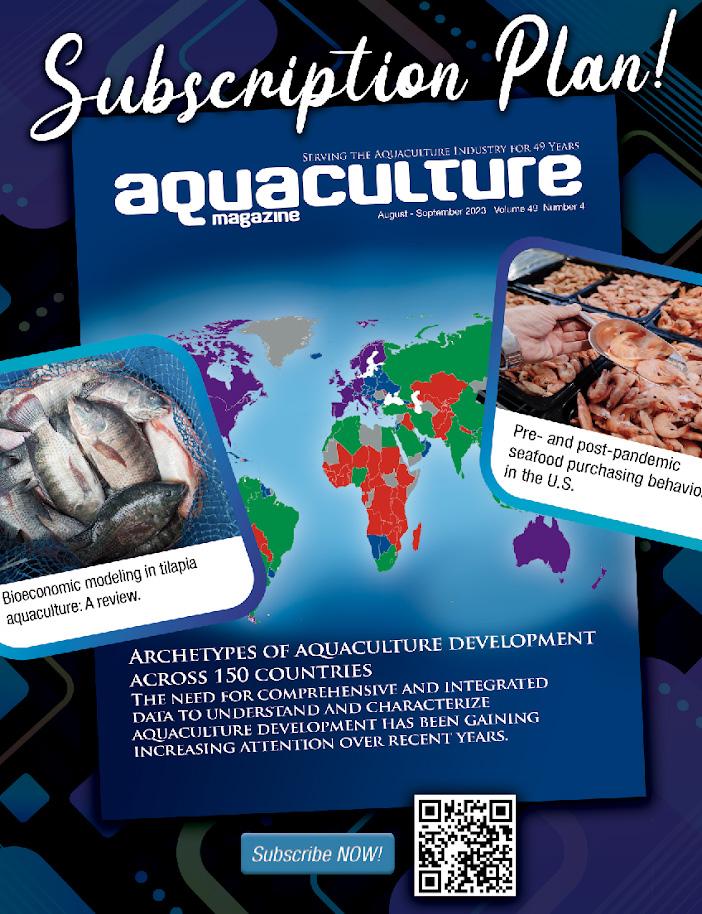




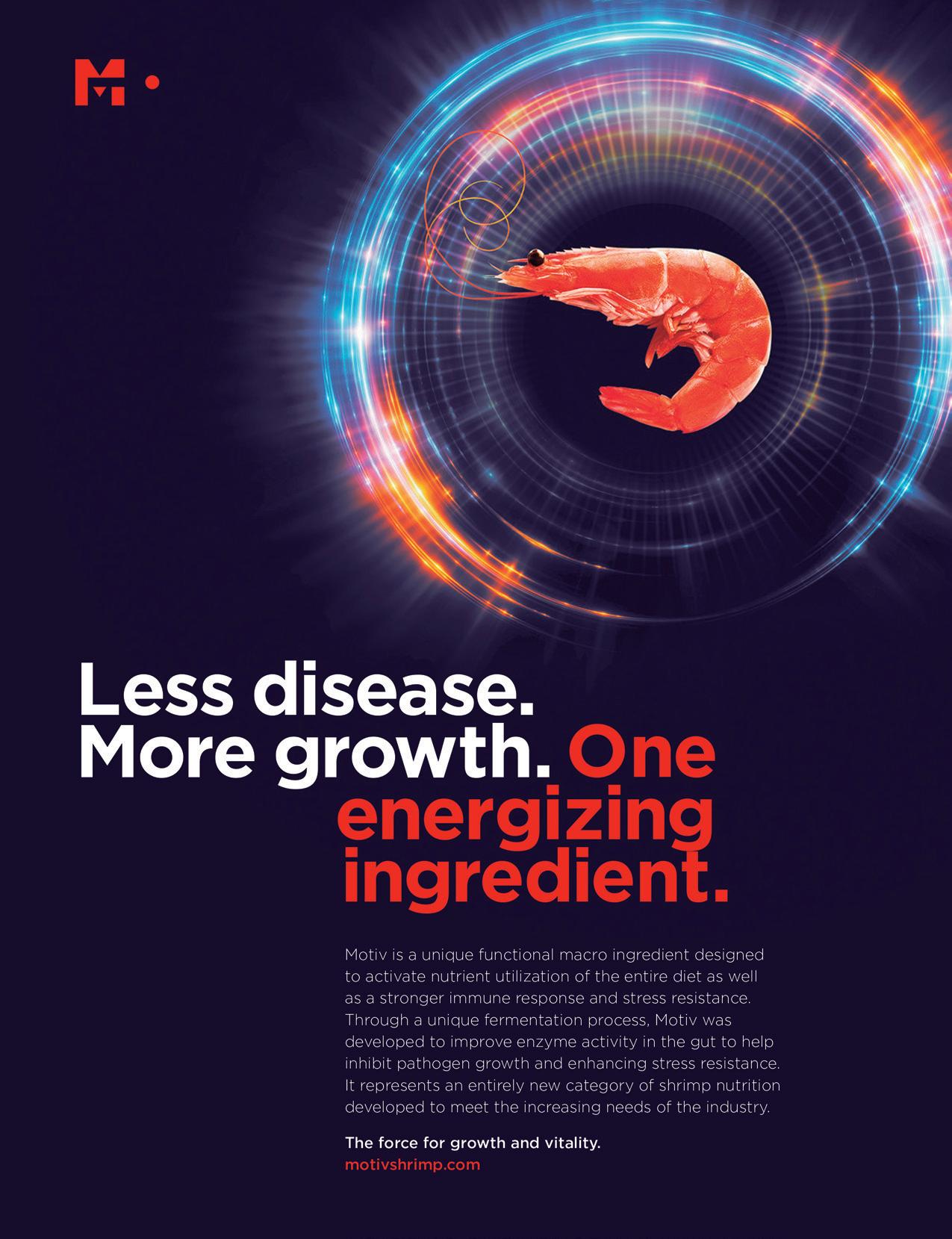

EDITOR’S COMMENTS
Competitive Aquaculture: Sustainable Development in the Face of Food Production
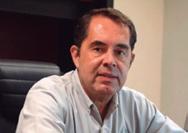
ARTICLE
Consumer Attitudes on Electrical Stunning of Sea Bream and Sea Bass in Greece’s Largest Markets
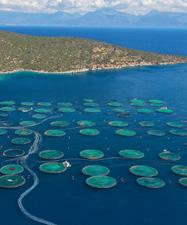
GREENHOUSES AND POND LINERS
Use of HDPE Geomembranes as Alternative to the Use of Concrete for Channels Lining in Remote Areas
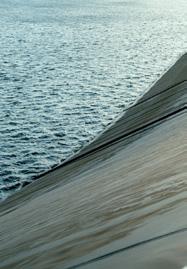

ARTICLE
Aquaculture: Balancing Sustainability and Production Through Innovation
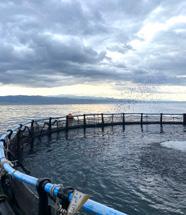
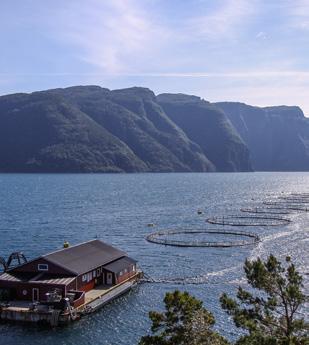
Serving the aquaculture industry for 50 years
Editor and Publisher
Salvador Meza / info@dpinternationalinc.com
Contributing Editor
Marco Linné Unzueta
Editorial Coordinator
Karelys Osta / edicion@dpinternationalinc.com
Editorial Design
Perla Neri / design@design-publications.com
Sales & Marketing Coordinator crm@dpinternationalinc.com
Sales Support Expert sse@dpinternationalinc.com
Operations Coordination
Johana Freire / opm@dpinternationalinc.com
Business Operations Manager
Adriana Zayas / administracion@design-publications.com
Subscriptions:iwantasubscription@dpinternationalinc.com
Design Publications International Inc. 401 E Sonterra Blvd. Sté. 375 San Antonio, TX. 78258 info@dpintertnatinonalinc.com
Office: +210 5043642
Office in Mexico: (+ 52) (33) 8000 0578 - Ext: 8578
Aquaculture Magazine (ISSN 0199-1388) is published bimontly, by Design Publications International Inc. All rights reserved. www.aquaculturemag.com
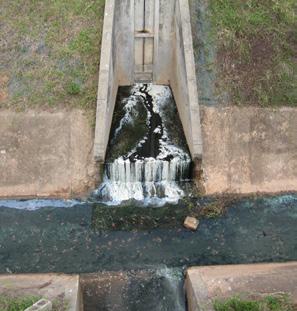

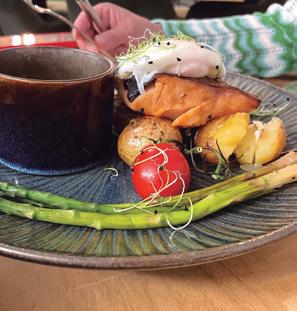

* Marco Linné Unzueta Associate Editor
The global community is currently facing multiple interrelated challenges, ranging from the effects of the current financial and economic crisis to increased vulnerability to climate change and extreme weather events. At the same time, it must address the pressing food and nutrition needs of a growing population with finite natural resources; therefore, it has been more than pertinent to generate action strategies to address these problems, so that, in aquaculture, the key goal should be to rethink the most pressing actions that will enable the development and strengthening of the activity, taking advantage of advances in nutrition, health, safety and traceability, taking advantage of Artificial Intelligence (AI) developments that will favor the use of resources, promoting and encouraging sustainable development to minimize the impact on the ecosystem.
This issue shows results in the environment of competitive innovations supported by AI, which lead to the establishment of eco-efficient schemes in aquaculture activities, as well as their integration in the generation of food of high nutritional value, employment and economic income for the population, as well as a source of inputs for the food industry and foreign exchange.
Sustainable and competitive aquaculture must overcome numerous technical, regulatory and economic barriers to innovation and
business development, and although the major challenges are technological innovation and measurement needs, the enabling environment - including regulatory simplification and stability, availability of investment capital for aquaculture enterprises, and the overall policy environment - must be considered for successful aquaculture development.
Therefore, it is especially important to establish or strengthen research focused on the development of biotechnologies that allow production and, to the extent possible, can replace ecosystem production and increase global food security, as well as increase the demand for other species, such as those native to each region, as ingredients in aquaculture foods and increase the amount of protein available for human consumption.
This is of utmost importance since fisheries and aquaculture make important contributions to global welfare and prosperity. Over the past 50 years, the global supply of fish products for human consumption has outpaced the growth of the world’s population; fish is now an essential source of nutritious food and animal protein for much of the world’s population. In addition, the sector provides livelihoods and income, both directly and indirectly, to a significant portion of the world’s population.
One of the main advantages of the aquaculture sector is that it can be widely developed geographically
in the different aquaculture regions of the world, and it is possible to find a value chain through the primary sub-sector activities are located on the country’s coastlines, inland waters and in extensive coastal lagoon areas. The industrial and processing plants of the secondary subsector tend to be clustered in the areas where primary production is concentrated. The diversity of productive processes that the sector incorporates and its geographic distribution, particularly those related to cultivation, are carried out in a communal manner and by means of traditional techniques, making the sector an important generator of conditions that promote social development in regional areas.
Therefore, it is of special relevance to establish research focused on the development of biotechnologies that can replace the production of the ecosystem and increase global food security, as well as increase the demand for native species of each region, as ingredients of aquaculture foods that allow the increase in the amount of protein available for human consumption, this information can be found in the different issues of this publication where the priority areas for the development of aquaculture production are identified, oriented to the productive sector to lead them to the improvement of aquaculture activities in order to optimize production levels and achieve greater competitiveness in the market.
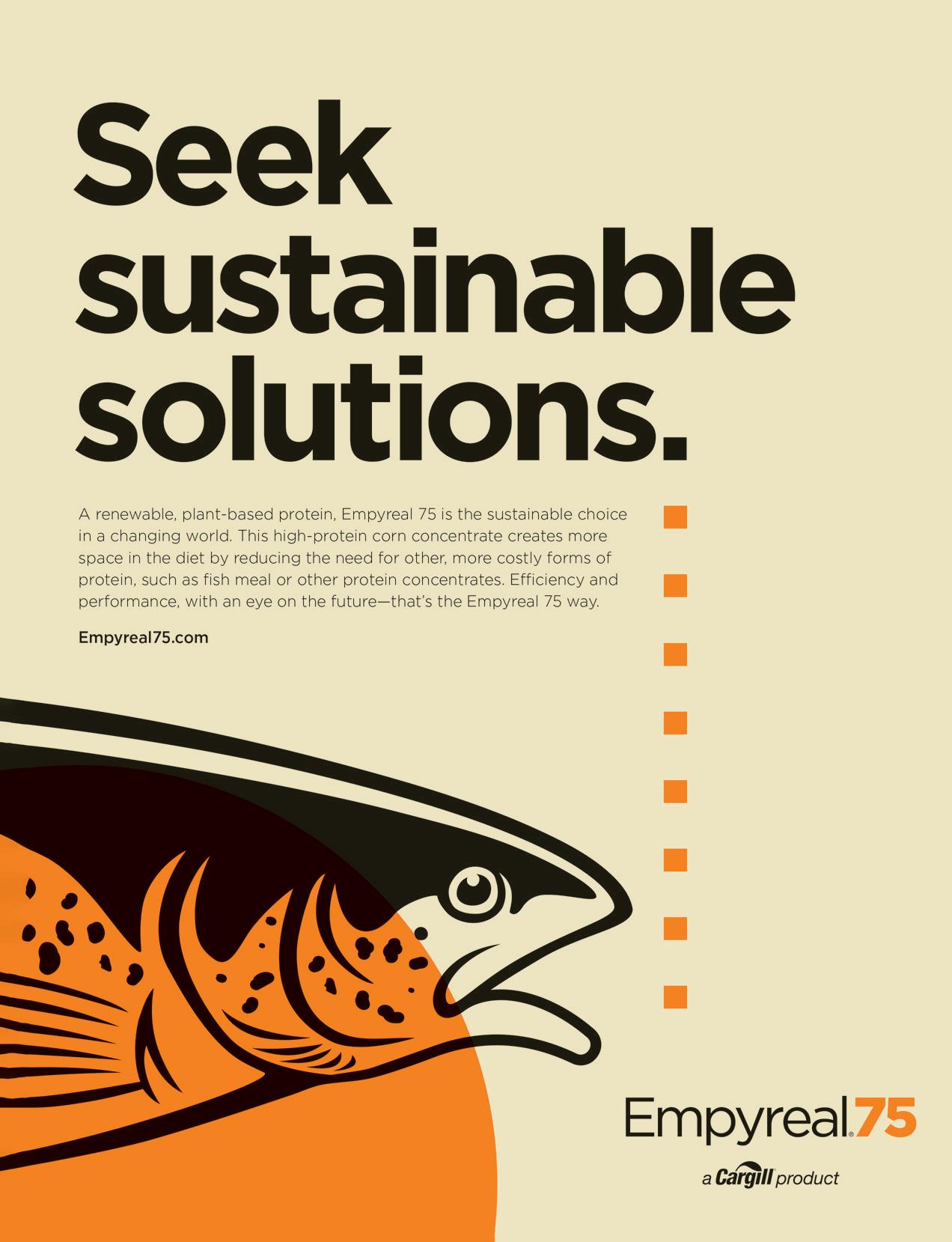
In June 2024, the Centre for Aquaculture
Progress commissioned Savanta, a leading market research company, to conduct a comprehensive study analyzing consumer preferences for fish welfare in Greece, Italy, Spain, and France. The representative survey that an overwhelming majority of consumers endorse humane slaughter practices for sea bream and sea bass.
* Aquaculture Magazine Editorial Team
Background
The Greek aquaculture industry has experienced significant growth and is expected to grow further, with sea
bream and sea bass being among the most commonly farmed fish species. However, the adoption of electrical stunning, a humane slaughter method that significantly improves
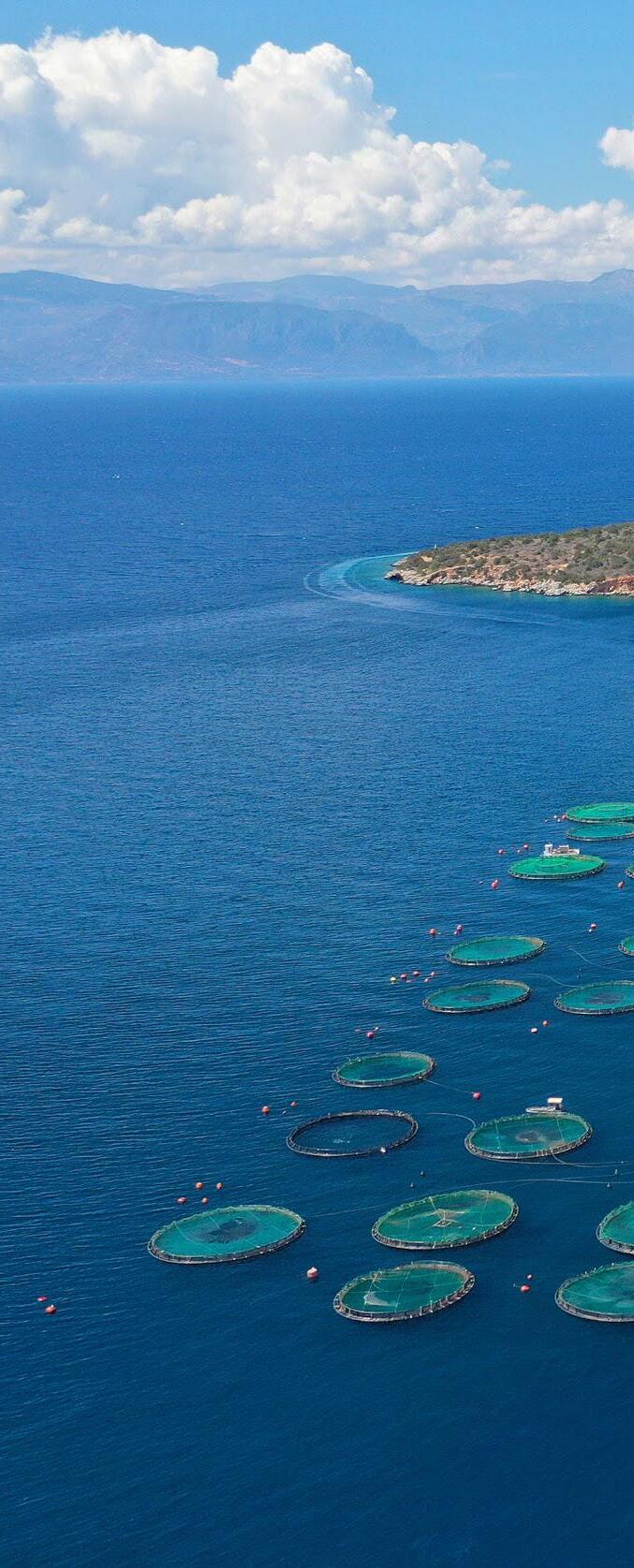
fish welfare, has only been adopted to a very limited extent for these species. This is despite scientific evidence demonstrating that stunning before slaughter reduces stress and
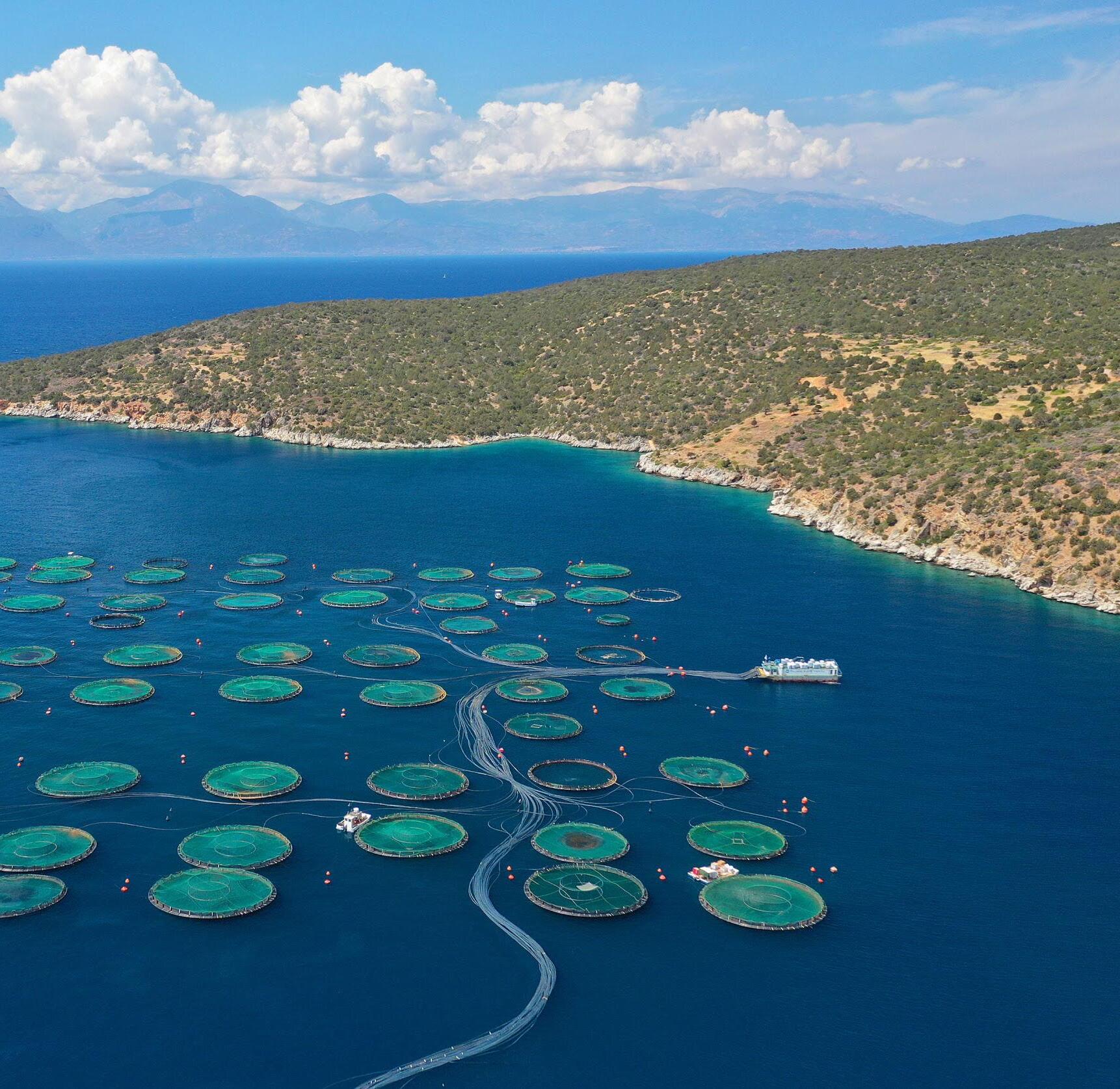
Furthermore, the study found that 80% of consumers who purchase sea bream and sea bass would be willing to pay an additional US$ 0.055 per serving (defined as 200 g) for fish that had been humanely slaughtered.
suffering in fish during the harvest process.
To evaluate the potential of new technologies in aquaculture, it is essential to consider a holistic perspective that takes into account the potential benefits for both consumers
and producers. Consumer awareness and concern for animal welfare have been on the rise, with many individuals seeking products that align with their values. This study aimed to assess consumer interest specifically in humanely slaughtered sea bream and sea bass, as strong consumer demand could provide an opportunity for producers to differentiate their products in an increasingly competitive market.
The objectives of this study were:
1. To evaluate consumer attitudes towards electrical stunning as a humane slaughter method for sea bream and sea bass; and 2. To determine consumers’ willingness to pay a premium for humanely slaughtered fish.
Savanta, a reputable market research company, conducted an online survey

using a targeted, structured questionnaire with closed-ended questions. The survey received responses from a total of 1,600 consumers equally distributed across Greece, Italy, Spain, and France. These countries were selected due to their significant market size of sea bream and sea bass for fish producers from Greece.
The sample was selected to be a national representative of the population in terms of age and gender, and near representative based on natural fallout for income and region. An online survey design was chosen.4
The survey results revealed a strong consumer preference for humane slaughter practices in the aquaculture of sea bream and sea bass.
A majority of 83% of respondents across all four countries expressed support for the use of pre-slaughter electrical stunning, indicating a widespread demand for improved fish welfare. This finding was consistent across all examined markets, suggesting that the desire for humane slaughter practices is consistent across Greece’s largest markets.
Furthermore, the study found that 80% of consumers who purchase sea bream and sea bass would be willing to pay an additional US$ 0.055 per serving (defined as 200 g) for fish that had been humanely slaughtered. While the observed willingness to pay more is similar across Greece, Italy, and France, it is lower in Spain. This result highlights the strong connection between consumer values and


purchasing decisions, as well as the potential for producers to capitalize on this demand by implementing more humane practices.
No major differences have been observed between different demographic groups (age, gender, and income levels), indicating broad support for these issues in the population.
The overwhelming majority of consumers (83%) favor the use of pre-slaughter electrical stunning for sea bream and sea bass as a humane slaughter method, with similar values observed across all examined markets. This finding, coupled with the fact that 80% of sea bream and sea bass consumers are willing to pay US$ 0.055 more per serving for humanely slaughtered fish, presents a compelling case for the aquaculture industry to adopt more welfare-friendly practices.
To position fish from Greek aquaculture as a responsible product for consumers to buy, fish welfare needs to be seriously considered. In today’s market, consumers are increasingly conscious of the ethical implications of their purchasing decisions, seeking out products that align with their values and demonstrate a commitment to animal welfare.
Relevant studies indicate that the price increase per serving of fish (200 g) would be significantly less than US$ 0.055. Estimates for Greek aquaculture suggest an increase of less than US$ 0.022 per serving. These findings underscore the cost-effectiveness of implementing preslaughter electrical stunning in the aquaculture of sea bream and sea bass, as it allows producers to meet strong consumer demand without incurring substantial additional costs.
The Centre for Aquaculture Progress is committed to supporting fish producers in advancing their slaughter processes, offering free and independent assistance to those interested in adopting more humane practices. By working together, the industry can respond to the clear consumer preference for improved fish welfare, while also enhancing the overall sustainability and competitiveness of the sector.
References and sources consulted by the author on the elaboration of this article are available under previous request to our editorial staff. Access the report data online: cap.fish/consumer2024
For more information, please contact info@centreforaquacultureprogress.org
This is a summarized version developed by the editorial team of Aquaculture Magazine based on the review article titled “CONSUMER ATTITUDES ON ELECTRICAL STUNNING OF SEA BREAM AND SEA BASS IN GREECE’S LARGEST MARKETS” developed by: Centre for Aquaculture Progress Including tables and figures.
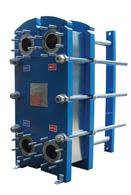


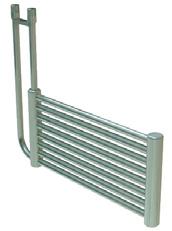
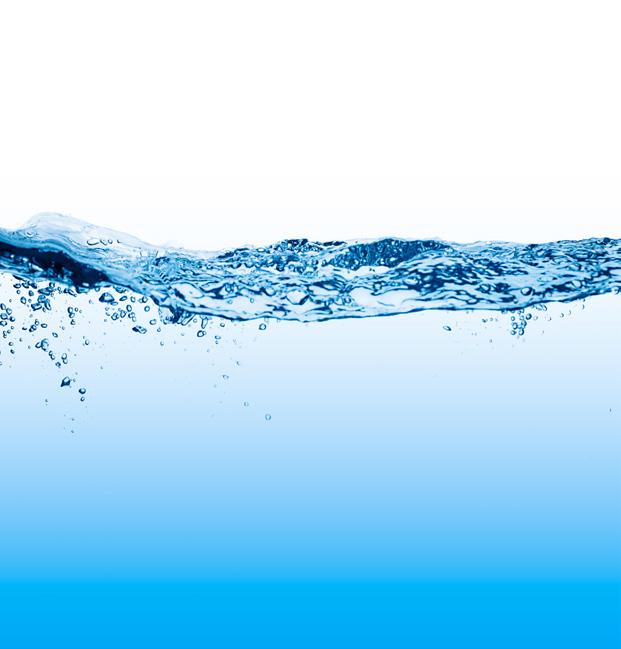
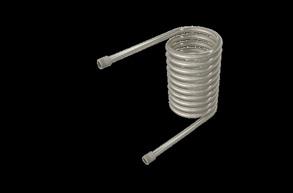
* By Aquaculture Magazine Editorial Team
The use of waterproof lining for channel surfaces can, in some cases, represent challenges in terms of cost, material availability, and capacity. Therefore, achieving optimal utilization of the water resources conveyed by channels is crucial for such projects. This paper presents a case study of a stormwater management project associated with a ditch system for a photovoltaic technology-based power generation plant located near the Salar de Atacama in the north of Chile. These structures capture runoff rainwater from contributing watersheds in the area. At the beginning, the project considered channels
In the quest for sustainable aquaculture solutions, innovative materials play a crucial role in enhancing water management systems. This article explores the transformative potential of high-density polyethylene (HDPE) geomembranes, specifically their application as lining systems for water transportation channels at a photovoltaic power plant in Antofagasta, Chile. Unlike traditional concrete, HDPE offers remarkable flexibility, adaptability, and long-lasting durability, making it an ideal choice for remote locations.
designed to be lined with concrete, but a study was requested to implement and validate a solution involving channels lined with high-density polyethylene (HDPE) geomembrane as a replacement. This change was made to avoid the use of concrete due to the logistical challenges and costs associated with the project’s location.
Geomembranes, made from highdensity polyethylene, are robust, UVresistant plastic laminates that serve as impermeable barriers against water, chemicals, and waste. Commonly used in mining, water storage, and aquaculture, they offer a superior al-
ternative to traditional concrete linings in water conveyance channels. Unlike concrete, which can crack and erode over time, leading to significant water losses and reduced capacity, geomembranes maintain their properties and efficiency for years. This resilience ensures optimal performance and reduces maintenance challenges, making geomembranes an ideal choice for effective water management solutions.
Geomembrane Lining Parameters
Manning’s coefficient
Manning’s coefficient is crucial for calculating the flow capacity of channels,

Geomembranes, made from high-density polyethylene, are robust, UV-resistant plastic laminates that serve as impermeable barriers against water, chemicals, and waste. Commonly used in mining, water storage, and aquaculture, they offer a superior alternative to traditional concrete linings in water conveyance channels.

with lower values indicating greater hydraulic capacity. The Manning equation is widely used for assessing gravity flow in pipes and channels, particularly those lined with highdensity polyethylene (HDPE). In Figure 1, values of Manning’s “n” (roughness coefficient) are presented. For HDPE-lined channels, the roughness coefficient (“n”) typically ranges from 0.009 to 0.015, depending on the geomembrane’s texture. Textured geo-
membranes require a higher “n” value, while smooth ones have a lower value. Research suggests a minimum “n” of less than 0.010 for smooth corrugated HDPE pipes, with Advanced Drainage Systems recommending 0.012 to accommodate real-world conditions.
To protect HDPE geomembranes from shear stresses due to fluid flow,
channel wall slopes should not exceed a maximum incline of H:V= 1:1. For steeper slopes (H:V= 2:3), adding geotextiles or geocomposites is recommended for support. Proper base preparation is crucial, as compacted, smooth surfaces minimize damage risks. Whenever possible, using a soil liner as bedding is advisable.
According to ADS, in a drainage system, adverse conditions that challenge the durability of the materials involved can be encountered in the soil, the air, and the effluent. The primary aspects of durability in gravity flow applications include: corrosion, mechanical strength, erosion (abrasion) of effluent, and effects of weather conditions such as sub-zero temperatures, freezing/unfreezing cycles, or exposure to ultraviolet radiation.

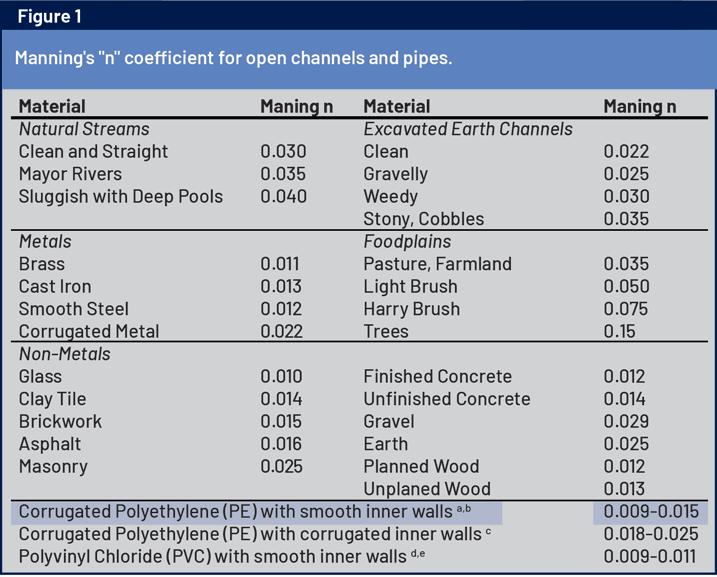
Corrosion: Plastics like polyethylene and polypropylene are highly inert and resistant to abrasives and galvanic corrosion, making them ideal for rainwater drainage. Choosing appropriate joint materials is crucial, especially in projects involving chemicals, as some, like high concentrations of hydrocarbons, can negatively impact joints. Alternative materials should be considered for challenging conditions.
Shear Strength Resistance: To ensure appropriate tensile strength for HDPE applications, base materials undergo frequent join strain tests, following the GRI-GM13 standard from the Geosynthetic Institute. This standard outline minimum strength requirements for smooth HDPE geomembrane thicknesses, highlight-
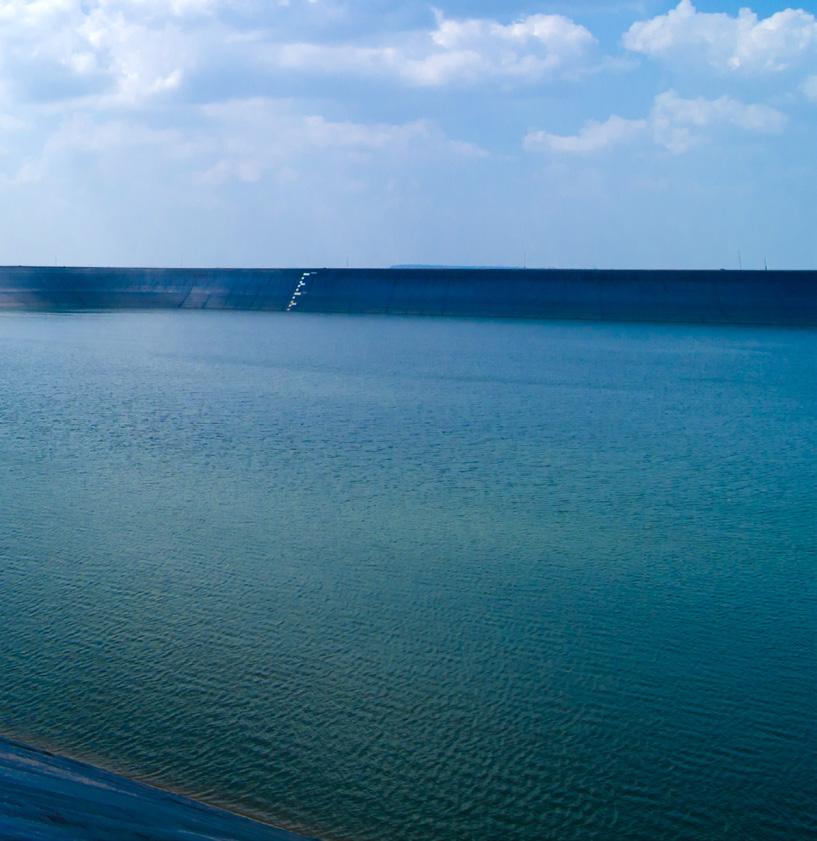
The primary aspects of durability in gravity flow applications include: corrosion, mechanical strength, erosion (abrasion) of effluent, and effects of weather conditions such as sub-zero temperatures, freezing/ unfreezing cycles, or exposure to ultraviolet radiation.
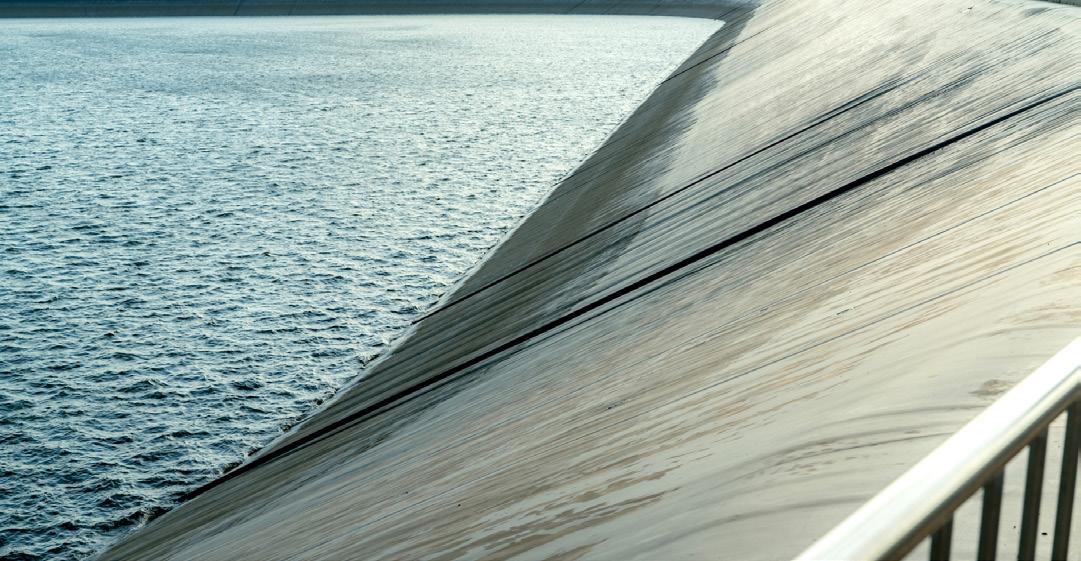
Industry standards test HDPE at 4°C or lower, but polyethylene remains functional down to -40°C, resisting brittleness and requiring no special precautions during installation in freezing conditions.
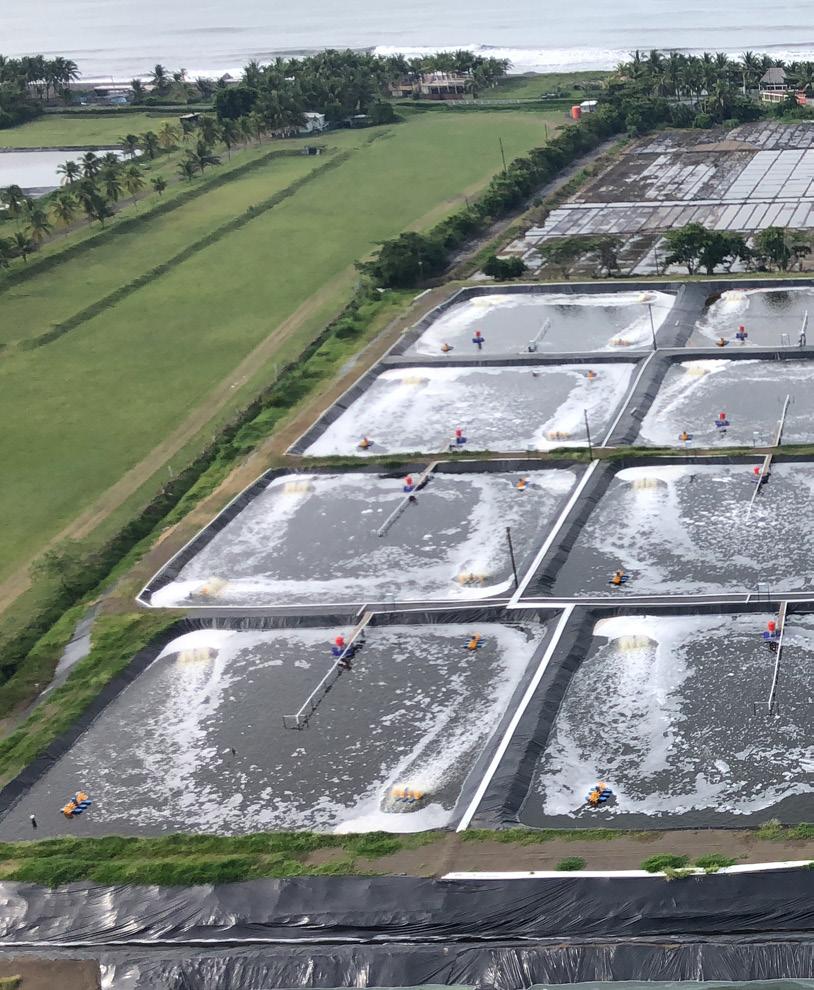
ing shear strength and elongation properties of 12% for elastic conditions and 700% at rupture, indicating strong resistance to deformation.
Erosion: The Saskatchewan Research Council conducted laboratory research on various materials to quantify the level of wear expected from controlled abrasive applications, using velocities of 7 fps (2.1 m/s) and 15 fps (4.6 m/s). The study’s results for 15 fps (4.6 m/s) velocities were extrapolated to obtain wear rates on an annual basis.
Sub-zero Condition Extreme: Extreme cold can make some plastic drainage products brittle, complicating installations. Industry standards test HDPE at 4°C or lower, but polyethylene remains functional down to -40°C, resisting brittleness and requiring no special precautions during installation in freezing conditions.
High Temperatures: High temperatures can cause black polyethylene geomembranes to absorb heat, with a maximum working temperature of 60°C (140°F), depending on
the chemicals involved. Temperature variations can lead to thermal contraction, causing potential joint openings. Given polyethylene’s thermal expansion coefficient, precautions against contraction are essential, particularly in exposed installations with extreme temperature gradients.
Higher flow velocities help prevent sediments in stormwater from depositing along the bottom of the channel. Reducing sediment can

also lower maintenance frequency and ensure that hydraulic function continues throughout its service lifecycle. However, these velocities must be maintained within the maximum performance limits of the channel and associated installation to avoid compromising the channel’s capacity.
Geomembrane Installation and Maintenance
For effective geomembrane installation, the surface must be smooth and free of sharp objects, excessive moisture, or dirt, with a stable ter-
rain. Long, straight sections should be installed lengthwise to reduce joints, while transverse installations require proper downstream overlaps. Geomembranes should be unrolled without tension and overlapped according to the welding machine used, typically 4 cm to 10 cm. Maintenance focuses on maintaining the waterproofing system and preventing leaks, particularly in exposed channels, ensuring they retain their designed transport capacity by avoiding sediment buildup and external material intrusion.
Geomembranes present an effective alternative to traditional concrete linings for water transportation channels, addressing issues such as cracking and erosion that can lead to system failure. Their high flexibility and strength enable them to adapt to irregular terrains, while their ease of transport and application enhance usability. With a lifespan exceeding 30 years, geomembranes offer excellent impermeability for water retention and perform well in extreme temperatures. For optimal functionality, maintaining a self-cleaning velocity of 0.9 m/s is essential to prevent sediment build-up. When dealing with high velocities or abrasive materials, using textured geomembranes or thicker options (2.0 mm+) can mitigate wear. It’s also advisable to select thicker geomembranes (1.5 - 2.0 mm) for UV protection and consider additives to minimize heat expansion. Proper installation techniques, including timing for welding in warm climates and anchoring in windy areas, are crucial for ensuring longterm stability and performance.
This article is sponsored by: REFF INDUSTRIES INC.

This is a summarized version developed by the editorial team of Aquaculture Magazine based on the review article titled “USE OF HDPE GEOMEMBRANES AS ALTERNATIVE TO THE USE OF CONCRETE FOR CHANNELS LINING IN REMOTE AREAS” developed by: León, A., Cornejo, F., and Zúñiga, D. - Axios Engineering SpA, Chile. The original article, including tables and figures, was published on MAY, 2024, through E3S WEB OF CONFERENCES- GEOAMERICAS 2024. The full version can be accessed online through this link: https://doi.org/10.1051/e3sconf/202456924001

* By Thodoris Antoniou and Dimitris Pafras.
The farming of aquatic organisms, or aquaculture, is quickly becoming as one of the most important global food production sectors. Aquaculture is a ray of hope for a future where there will be a greater need for wholesome, sustainable food. Aquaculture provides prospects for a closer alignment with the environment and natural world, in addition to its economic and nutritional benefits. This article highlights the industry’s capacity to improve society and ecosystems by emphasizing how important it is to maintain a healthy balance between environmental stewardship and production. Through adopting a more holistic and spiritual viewpoint, we may reveal the numerous benefits that aquaculture can offer to the earth and its inhabitants.
A plentiful and dependable source of protein, aquaculture contributes to feeding the world’s expanding population. Aquaculture uses less energy, freshwater, and land than many terrestrial farming methods. It provides a scalable food production option that can be put into practice without vying for essential land resources required for agriculture. Aquaculture holds the promise of feeding millions of people while protecting our natural environments through the promotion of sustainable fish farming methods.
When managed with care, aquaculture can enhance the health of ecosystems rather than degrade them. Certain farming techniques, such as Integrated MultiTrophic Aquaculture (IMTA), mimic the balance of natural ecosystems. IMTA involves raising different species together in a system where each species contributes to the overall health of the environment. For example, fish farms can cultivate seaweed and shellfish, which help purify water and absorb excess nutrients, fostering a symbiotic relationship between the species and the surrounding environment.
Aquaculture provides a way to mitigate the negative effects of overfishing on marine biodiversity while
Aquaculture provides prospects for a closer alignment with the environment and natural world, in addition to its economic and nutritional benefits. This article highlights the industry’s capacity to improve society and ecosystems by emphasizing how important it is to maintain a healthy balance between environmental stewardship and production.
also relieving the strain on wild fish populations. Seafood can be produced under regulated conditions to satisfy consumer demand without damaging ocean resources. By supporting the resurgence of wild fish populations, the ocean’s natural equilibrium is preserved, and biodiversity
is preserved. Aquaculture can thus be viewed as a protector of marine life, safeguarding delicate ecosystems for coming generations.
The advancements in aquaculture are not only beneficial for food production but also for the development of environmentally friendly tech-


Aquaculture holds the promise of feeding millions of people while protecting our natural environments through the promotion of sustainable fish farming methods.
nologies. Recirculating Aquaculture Systems (RAS) represent one such innovation. These closedloop systems recycle water, minimize waste, and prevent pollution, all while ensuring the highest levels of fish welfare. The technologies driving aquaculture today are a testament to humanity’s capacity to innovate in ways that align with nature’s rhythms, offering a glimpse of a future where production systems leave a light ecological footprint.
Because it creates jobs and economic possibilities, aquaculture is a major factor in the improvement of coastal towns. In addition to supporting sustainable practices that are in line with the cultural and spiritual beliefs of those who live by the sea,
it can boost local economy. Growing aquaculture businesses can promote water stewardship and motivate local people to take up marine environment care, combining environmental preservation with economic growth.
Certain aquaculture practices can actively contribute to environmental healing. For example, seaweed farming helps to sequester carbon dioxide, reducing greenhouse gases and mitigating the impacts of climate change. Shellfish farms filter water and improve water quality, enhancing the health of marine ecosystems. These practices highlight the potential for aquaculture to be a force for restoration and renewal, echoing the spiritual call to care for and heal the Earth.
Aquaculture has a bright future because of developments that put environmental protection and sustainability first. With continued technological advancements, the sector will increasingly serve as an example of how human creativity can coexist with the natural world as we investigate new feed sources and farming techniques. We can make sure aquaculture stays a force for good in the world by coordinating it with spiritual and environmental principles.
The circular economy theory provides the perfect foundation for aquaculture. Aquaculture systems can shut the loop on resource consumption by converting waste products into resources, such as using fish waste to produce bioenergy or fertil-
ize crops. This approach decreases waste while simultaneously encouraging a stewardship and caring mentality.
Innovations in substitute feed materials, like algae, plantbased diets, and insect protein, are lessening the dependency on fishmeal made from wild fish. These substitutes not only reduce feed production’s environmental impact but also support the preservation of natural ecosystems and the mitigation of harm to marine life.
In conclusion, aquaculture has the potential to both protect the environment and meet the world’s expanding food needs, but only if sustainability is given priority. The industry’s ability to develop and adapt, adopting strategies that guarantee a balance
between ecosystem health and production, will determine its future. Aquaculture may flourish in a way that benefits people and the environment through scientific discoveries, technological developments, and a dedication to sustainability. This well-rounded strategy will be necessary to ensure aquaculture’s continued role as a major contributor to the world’s food security.
The
technologies driving aquaculture today are a testament to humanity’s capacity to innovate in ways that align with nature’s rhythms, offering a glimpse of a future where production systems leave a light ecological footprint.
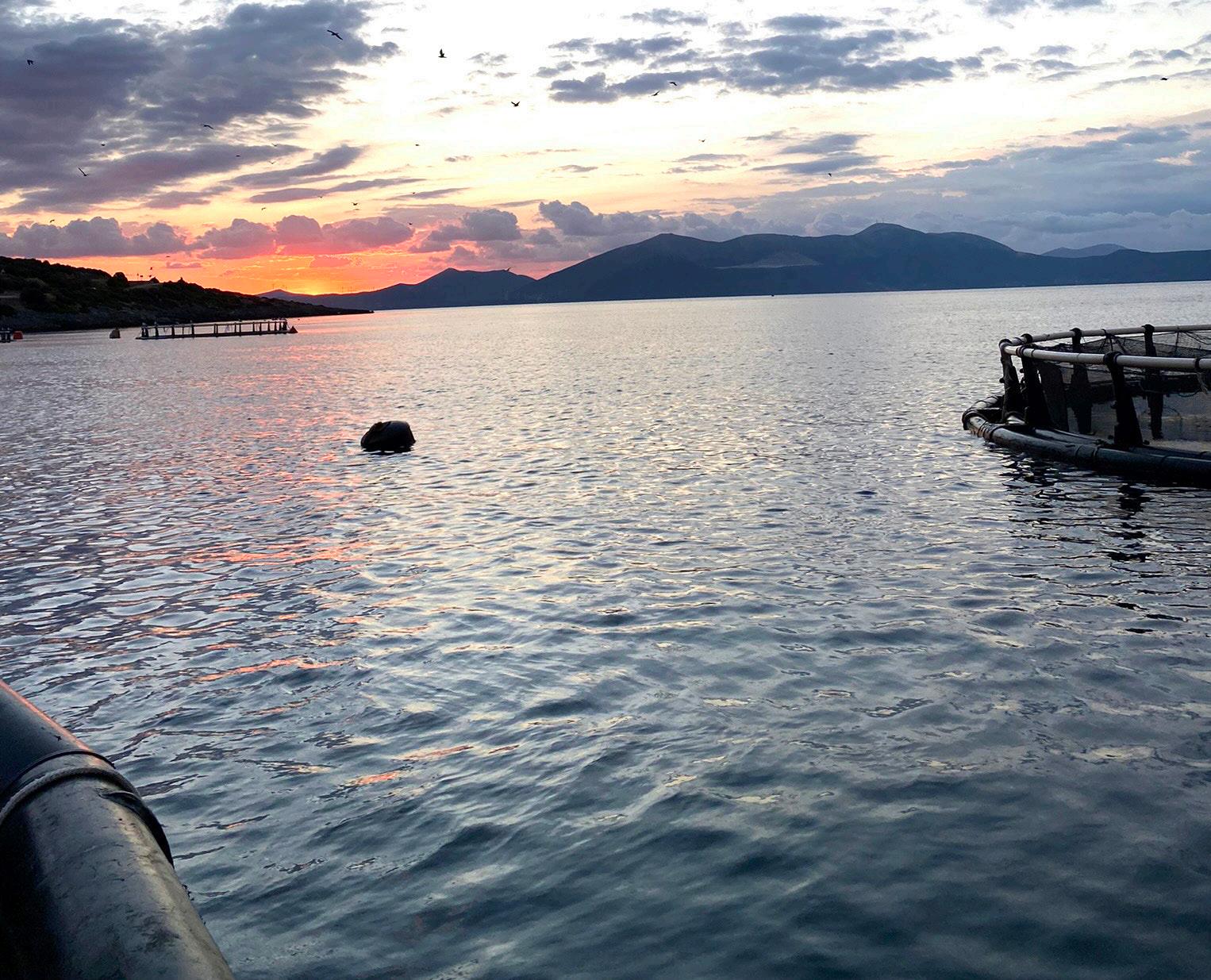
* By Aquaculture Magazine Editorial Team
Aquatic foods represent a muchneeded healthy food source in the global fight against malnutrition and achieving food security. Aquatic animal foods including fish, crustaceans, mollusks, and other invertebrate animals destined for direct human consumption are referred to in this commentary as Fish and Seafood. Despite the numerous nutritional merits of increased aquatic food consumption compared with terrestrial meat and processed meat-based fast-food products (Tacon and Metian, 2013; FAO & WHO, 2019; Ahern et al., 2021; Golden et al., 2021; Von Braun et al., 2021; Bavinck et al., 2023; Naylor et al., 2023; Tacon et al., 2023), there is also growing concern about the long-term
sustainability (or not) of aquatic food supplies to meet current and future needs (Clonan et al., 2012; Thurstan and Roberts, 2014; Kobayashi et al., 2015; Roheim et al., 2018; Costello et al., 2020; Farmery et al., 2022). This commentary discusses trends in aquatic food supply over the past decade from 2010 to 2020 at global, regional, and national levels within main-producing countries, and the potential to sustain the aquatic food supply with respect to human population growth.
Although total global fish and seafood food supply has increased over the past decade from 18.59 kg/capita

in 2010 to 20.49 kg/capita in 2020 (compound annual growth rate –CAGR of 0.98%/year), fish supply has not kept up with human population growth over the same period (CAGR 0.98% and 1.21%, respectively; Table 1, FAO, 2023a). A similar situation ex-
This commentary reviews total aquatic food supply from aquaculture and capture fisheries from 2010 to 2020 at global, regional, and national levels within main producing countries. If aquatic food supplies from aquaculture and inland/marine capture fisheries are to make an increasing global contribution to healthy diets, then the increased production and market availability of these products needs to be promoted by governments and actively encouraged and stimulated, particularly within the African continent.

isted with total terrestrial meat food supply, which only increased from 41.52 kg/capita to 42.76 kg/capita from 2010 to 2020 (CAGR 0.27%; Table 1).
Notwithstanding these global trends, Asia was the only region where the growth in aquatic fish and
seafood supply exceeded population growth (1.70%/year and 0.98%/ year, respectively (Table 1). Moreover, although aquatic fish and seafood supply increased in Central America, South America, and North America (by 0.91%/ year, 0.65%/year and 0.48%/
year, respectively), annual growth in supply was below population growth within these regions (1.32%/year, 0.93%/year, and 0.63%/year, respectively; Table 1). Of particular concern was the decrease in fish and seafood supply within the African region, de-
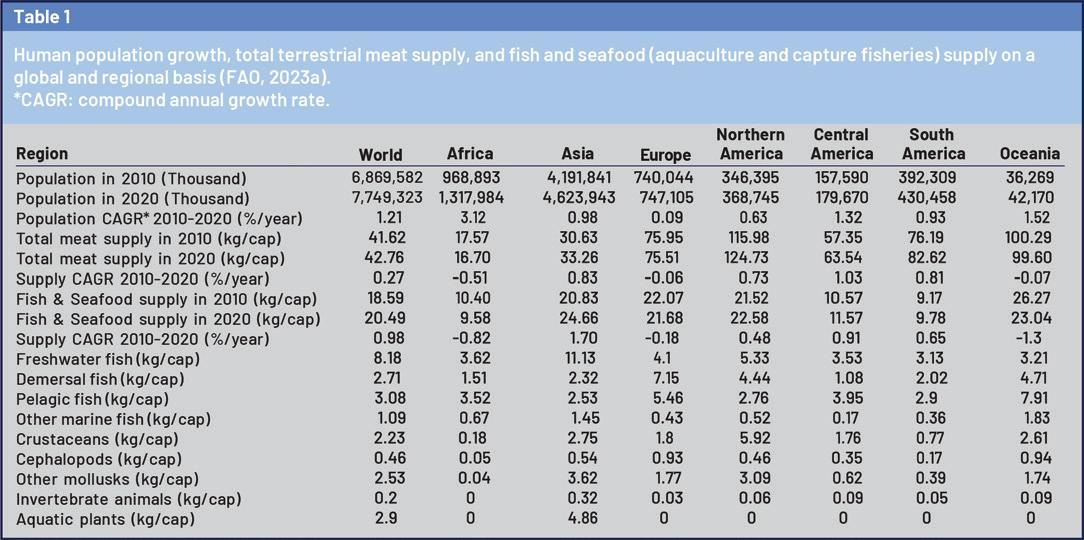
Of particular concern was the decrease in fish and seafood supply within the African region, decreasing from 10.40 kg/capita to 9.58 kg/capita, whilst population growth increased by 3.12%/year over the same period.

creasing from 10.40 kg/capita to 9.58 kg/capita, whilst population growth increased by 3.12%/year over the same period. A similar trend was also observed in Oceania and Europe, where
fish and seafood supply decreased by −1.30%/year in Oceania (population growth 1.52%/year) and −0.18%/year in Europe (population growth 0.09%/ year; Table 1, FAO, 2023a).
In marked contrast to the Asian region, where the bulk of fish and sea-
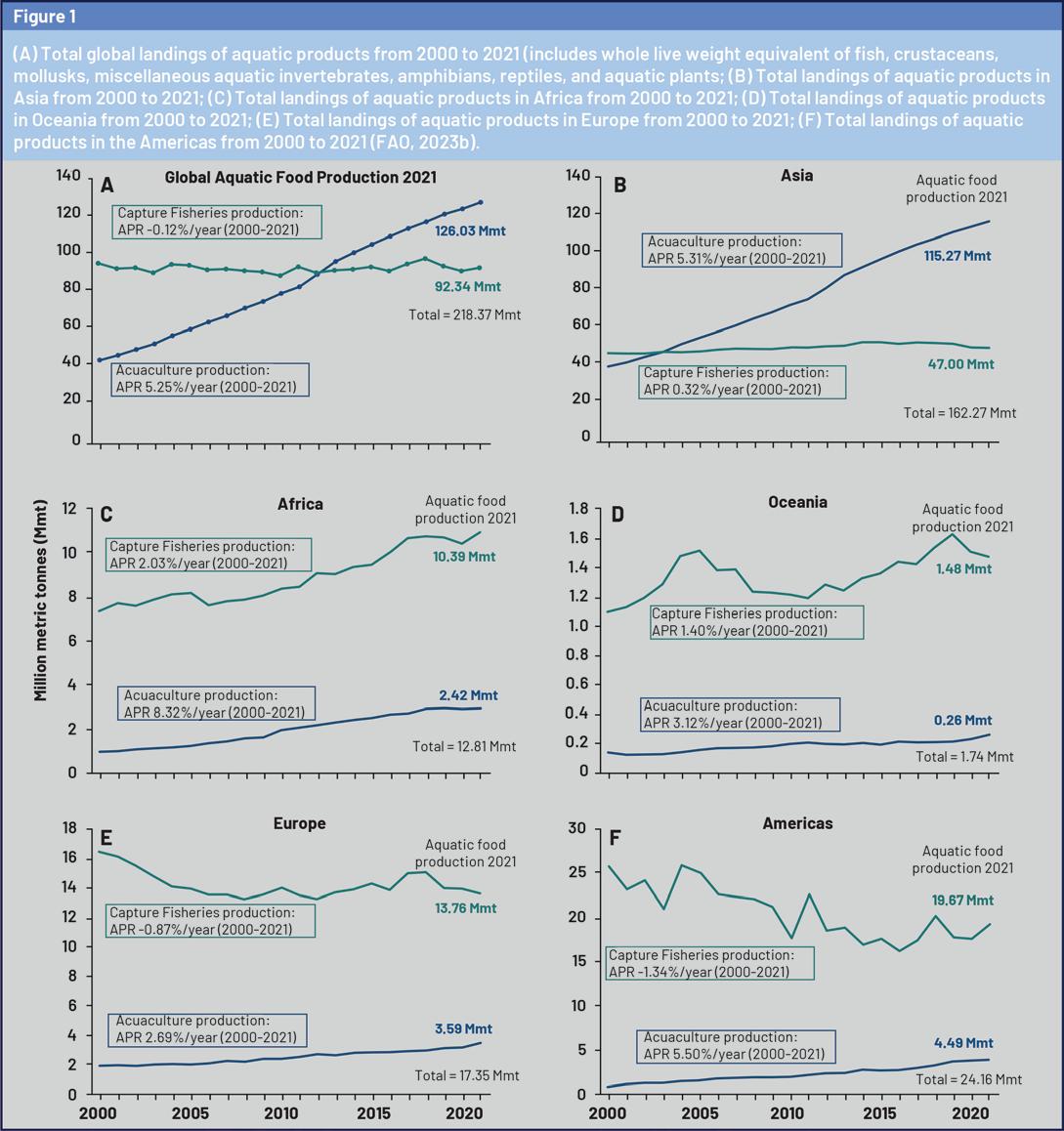
food supply is primarily sourced from increased aquaculture production (the Asian region producing 91.6% of total global aquaculture production in 2021, and production increased at a CAGR of 5.31%/year since 2000, compared with a CAGR of 0.32% for capture fisheries in the region: Table 2; FAO, 2023b); this was not the case for other regions where marine cap-
ture fisheries still dominate fish and seafood supply (Figure 1).
Although freshwater fish species (usually feeding low on the aquatic food chain) contributed to over half of total fish supply globally and within the Asian region in 2020 (54.3% and 63.8%, respectively), this was not the
case in other regions (Figure 2). Marine pelagic and demersal fish species (usually feeding higher on the aquatic food chain) dominated fish supply in those regions where capture fisheries still overshadow aquaculture production, including Central America 59.6% total food fish supply, Africa 61.2%, South America 62.8%, Europe 76.1%, and Oceania 81.8% (Table 2, Figure 1).

It is important to note that cultured aquatic plants or seaweeds contributed an additional 2.9 kg/capita globally and 4.86 kg/capita to total fish and seafood food supply in the Asian region in 2020 (live weight basis); total aquatic food supply including aquatic plants being 20.49 + 2.9 (23.39 kg/capita: globally) and 24.66 + 4.86 (29.52 kg/capita: Asia; Figure 2, Table 1, FAO, 2023a).
Table 3 shows per capita fish and seafood supply within the top 20 aquaculture producers in 2020 and graphically in Figure 3 (including supply trends 2010 to 2020 for China, Indonesia, India, Viet Nam, Bangladesh, South Korea, Japan, and the USA).
Based on the data shown, the following positive and negative trends were evident:
» Per capita fish and seafood supply was highest in South Korea 55.27 kg, Malaysia 54.70 kg, Norway 50.18 kg, Japan 46.2 kg, Myanmar 45.02 kg, Indonesia 44.44 kg, China 39.91 kg, and Viet Nam 39.56 kg; » Growth in per capita annual supply of fish and seafood was great-
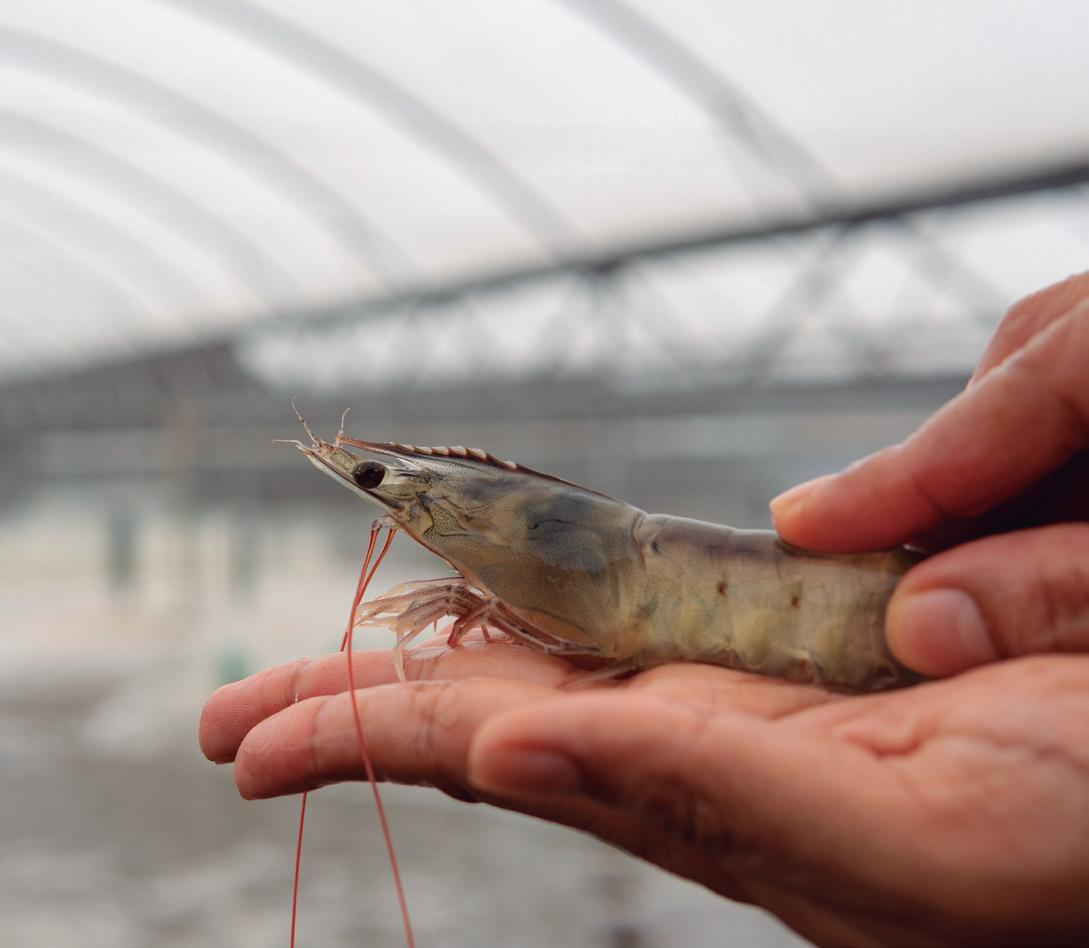
It is important to note that cultured aquatic plants or seaweeds contributed an additional 2.9 kg/capita globally and 4.86 kg/capita to total fish and seafood food supply in the Asian region in 2020 (live weight basis); total aquatic food supply including aquatic plants being 20.49 + 2.9 (23.39 kg/capita: globally) and 24.66 + 4.86 (29.52 kg/capita: Asia).
est for Indonesia 4.7%/year, followed by Iran 3.8%, India 3.6%, Bangladesh 2.9%, Egypt 2.5%, and China 2.2%;
» Growth in per capita supply was higher than population growth in China 0.5%/year, Indonesia 1.2%, India 1.1%, Viet Nam 1.0%, Bangladesh 1.1%, Egypt 2.1%, Thailand 0.4%, and South Korea DPR 0.5%;
» Growth in per capita supply was lower than population growth in Ecuador 1.6%, Philippines 1.5%/ year, Turkey 1.5%, Chile 1.1%, Nor-
way 1.0%, Brazil 0.8%, Myanmar 0.7%, South Korea 0.3%, and Japan 0.2%;
» Despite growth of the aquaculture sector in most Asian countries, Europe (Norway, Turkey) and the Americas (Ecuador, Brazil), annual per capita fish and seafood supply decreased in Turkey −2.1%, Philippines −1.4%, Japan −1.3%, Malaysia −1.1%, Norway −0.8%, Brazil −0.6%, Ecuador −0.4%, and the South Korea −0.2% between 2010 and 2020;
» Highest total per capita supply of finfish (includes freshwater fish, demersal fish, pelagic fish, and other marine fish) in 2020: Malaysia 46.1 kg/capita, Myanmar 44.93 kg/capita, Indonesia 39.32 kg/capita, Norway 39.23 kg/capita, and Viet Nam 28.39 kg/capita;
» Highest total per capita supply of crustaceans in 2020: Norway 10.05 kg, USA 8.18 kg, Japan 6.14 kg, China 5.95 kg, and Viet Nam 5.26 kg;
» Highest total per capita supply of cephalopods in 2020: South Korea
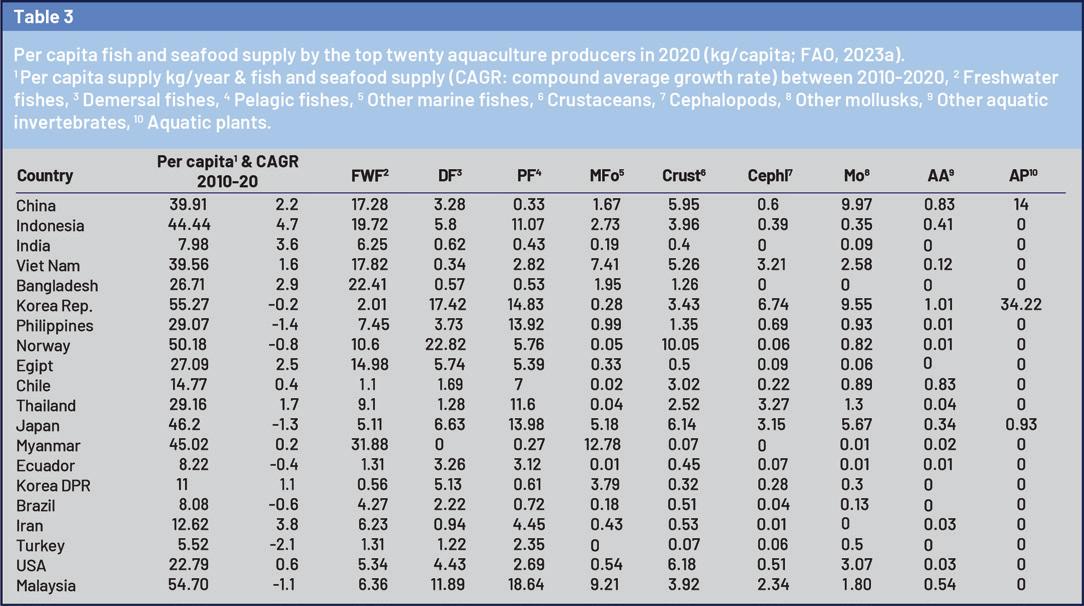
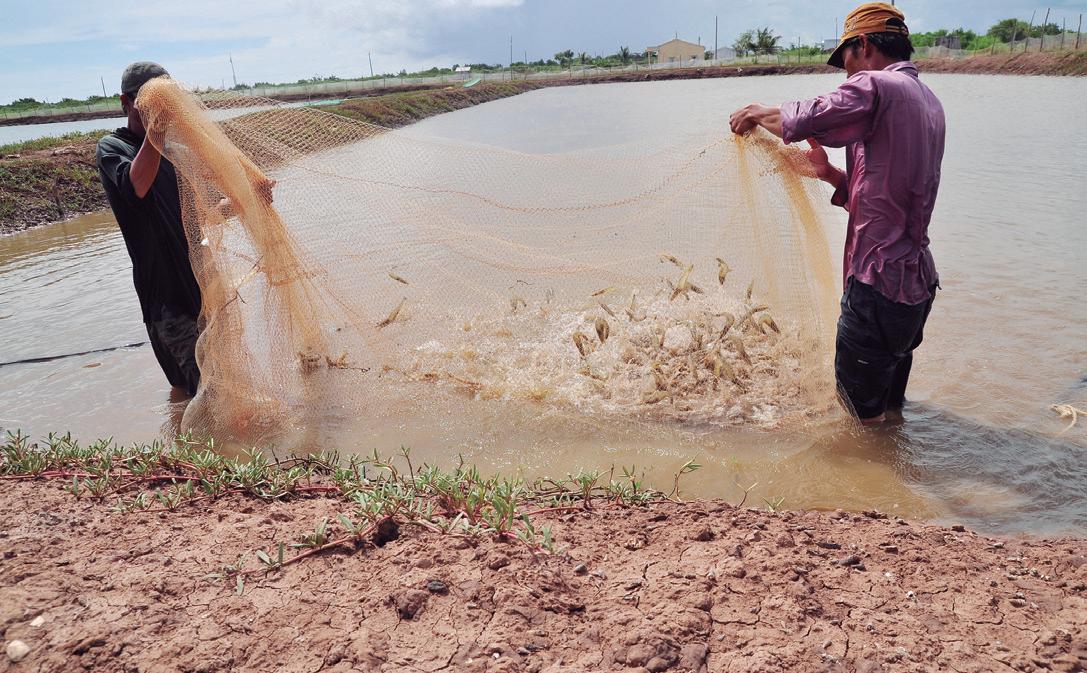
Despite growth of the aquaculture sector in most Asian countries, Europe (Norway, Turkey) and the Americas (Ecuador, Brazil), annual per capita fish and seafood supply decreased in Turkey −2.1%, Philippines −1.4%, Japan −1.3%, Malaysia −1.1%, Norway −0.8%, Brazil −0.6%, Ecuador −0.4%, and the South Korea −0.2% between 2010 and 2020.
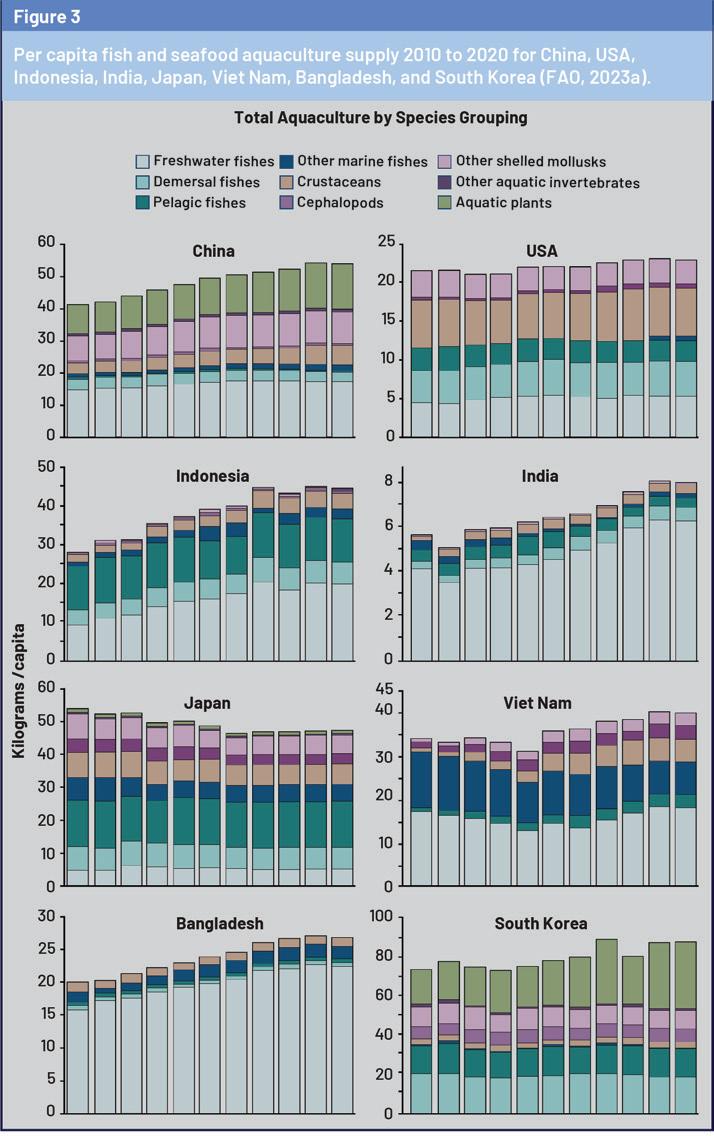
6.74 kg, Thailand 3.27 kg, Viet Nam 3.21 kg, and Japan 3.15 kg;
» Highest total per capita supply of shelled mollusks in 2020: China 9.97 kg, South Korea 9.55 kg, Japan 5.67 kg, and the USA 3.70 kg;
» Highest total per capita supply of aquatic plants in 2020: South Korea 34.22 kg, China 14 kg, and Japan 0.93 kg;
» Freshwater fish species constituted 83.9% and 78.3% of total aquaculture fish and seafood supply in Bangladesh and India in 2020, respectively (Figure 3).
If aquatic fish and seafood food supplies from aquaculture and capture
fisheries are to make an increasing global contribution to healthy diets (FAO & WHO, 2019; Ahern et al., 2021; Naylor et al., 2021; Costa-Pierce et al., 2022; Peng et al., 2023; Tacon et al., 2020), then the increased sustainable production (in the case of aquaculture) and consumption of aquatic food products, needs to be stimulated and encouraged. In the case of the African continent, the increased production and consumption of nonfed species such as farmed mollusks and aquatic plants should also be promoted and encouraged actively. These species supplied less than 1% of the total aquatic food supply in 2020, with production not being dependent upon the external provision of compound feed inputs (Chopin and Tacon, 2020; Peng et al., 2024). Clearly, increased sustainable aquaculture production and enhanced sustainably managed capture fisheries production should be promoted by governments and actively promoted to provide a healthy and sustainable food source for the global population to help combat malnutrition and address food security – a growing issue and concern with increasing climate-related impacts on food supply chains.
This is a summarized version developed by the editorial team of Aquaculture Magazine based on the review article titled “CRITICAL NEED TO INCREASE AQUATIC FOOD PRODUCTION AND FOOD SUPPLY FROM AQUACULTURE AND CAPTURE FISHERIES: TRENDS AND” developed by: TACON, A. - Aquahana LLC , Kailua, HI, USA; and SHUMWAY, S. - University of Connecticut, USA. The original article was published, including tables and figures, on MARCH, 2024, through REVIEWS IN FISHERIES SCIENCE & AQUACULTURE. The full version can be accessed online through this DOI: 10.1080/23308249.2024.2324321.
* By Bhavesh Choudhary, Arup Das and Nayan Chouhan
Introduction
Aquatic habitats are encountering previously unheard-of difficulties as a result of climate change, which is having an increasingly noticeable effect on global ecosystems. The impacts of climate
change on fish reproduction have become a significant area of concern among the many ecological problems. The ongoing changes in global climate patterns pose significant risks to the reproductive success of fish populations. Rising water tem-
peratures can shift the geographical distribution of fish species, alter reproductive timing, and reduce the availability of suitable spawning habitats. Moreover, increased frequency of temperature extremes threatens the sustainability of fish populations
Temperature is a pivotal environmental factor affecting the physiological processes in fish, including reproduction. Fish, being ectothermic organisms, have their body temperature and metabolic rates dictated by the surrounding water temperature. Consequently, fluctuations in temperature can significantly impact their reproductive physiology, including gametogenesis, spawning behavior, and embryonic development.
The spawning migration of sockeye salmon (Oncorhynchus nerka) is initiated by precise temperature thresholds, with deviations potentially disrupting the timing and success of spawning events.
worldwide. Predictive models suggest that many species, particularly those in tropical and temperate regions, may face severe. This article explores the complex interactions between fish reproductive biology and temperature swings, their effect and impacts on aquatic animal reproduction.
In aquatic biology, the impact of temperature on fish reproductive, sex determination, and sex change is a complex and important topic. Changes in temperature impact the expression
of genes linked to the manufacturing of reproductive hormones, which in turn causes modifications in the hormonal equilibrium and enzyme activity that are essential for fish reproduction. Higher temperatures can cause both male and female reproductive cycle disruption by timing ovulation and spawning incorrectly, especially in tropical regions. Furthermore, increasing temperatures have the potential to distort sex ratios in species that have either environmental sex determination (ESD) or genetic sex determination impacted by temperature (GSD + TE). Temperature affects the expression of genes involved in aromatase biosynthesis in sequentially hermaphrodite species, which in turn affects the direction and timing of sex change.
Temperature directly influences metabolic activities at the cellular level, affecting the synthesis, structure, and activity of neurohormones, hormones, and enzymatic complexes involved in steroidogenesis (Nakamura et al., 2003). Fluctuations in temperature affect gene expression controlling the synthesis of reproductive hormones and enzymes crucial for HPG axis functioning (Baroiller et al., 1999). Fish reproduction is profoundly influenced by environmental temperature, which plays a critical
role in determining the reproductive success and population dynamics of various fish species. This paper explores the physiological impacts of temperature on fish reproduction, emphasizing the mechanisms involved and the potential implications of climate change. Temperature is a pivotal environmental factor affecting the physiological processes in fish, including reproduction. Fish, being ectothermic organisms, have their body temperature and metabolic rates dictated by the surrounding water temperature. Consequently, fluctuations in temperature can significantly impact their reproductive physiology, including gametogenesis, spawning behavior, and embryonic development.
Gametogenesis, the process of producing eggs and sperm in fish, is highly sensitive to temperature fluctuations. Optimal temperature ranges are essential for the proper development of gonads in both male and female fish. Deviations from these optimal ranges can result in reduced gamete quality and quantity, subsequently affecting fertility rates. For instance, in Atlantic salmon (Salmo salar), elevated temperatures have been associated with impaired spermatogenesis and decreased sperm motility, impacting reproductive success (Wilson and Primack, 2019).
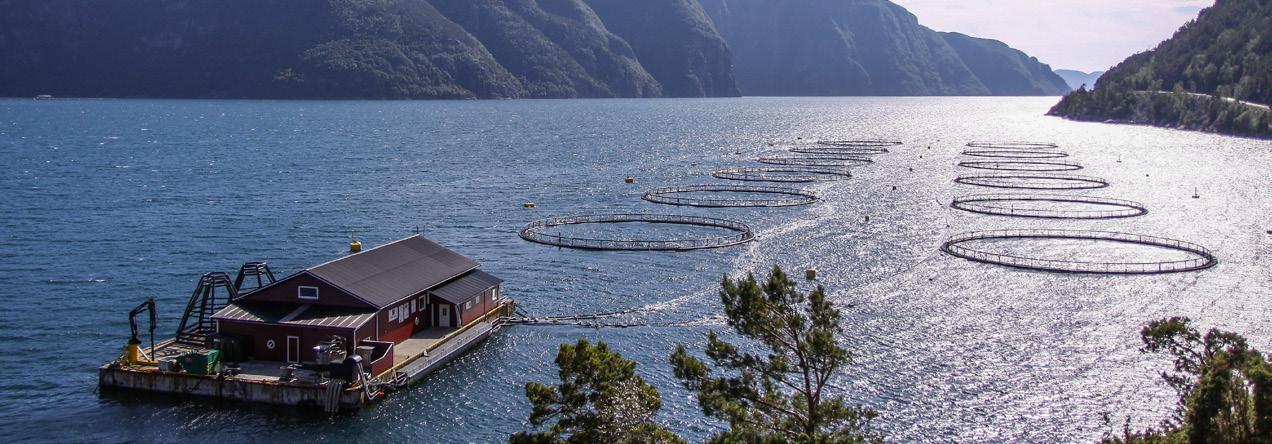
Temperature also plays a critical role in influencing the external behaviors related to reproduction, such as spawning migrations and site selection. Many fish species rely on specific temperature cues to trigger these behaviors. For example, the spawning migration of sockeye salmon (Oncorhynchus nerka) is initiated by precise temperature thresholds, with deviations potentially disrupting the timing and success of spawning events. Similarly, coral reef fish like the clownfish (Amphiprioninae) show synchronized spawning behaviors closely linked to temperature changes (Wilson and Primack, 2019).
Post-fertilization, temperature remains crucial for embryonic development in fish. The rate of embryogenesis is temperature-dependent, with optimal temperatures promoting healthy development and hatching success. Extreme temperatures can cause developmental abnormalities and increase mortality rates in fish embryos. For instance, in zebrafish
(Danio rerio), temperatures above 28°C have been linked to developmental defects and reduced hatchling survival (Wilson and Primack, 2019).
Slight temperature increases can disrupt the endocrinal activities involved in fish reproduction, particularly in tropical species, leading to mistiming in reproductive cycles (Pankhurst and Munday et al., 2011). High temperatures can advance or truncate the reproduction season in different fish species, potentially affecting ovulation, spawning timing, and gamete quality (Nakamura et al., 2003).
Rising temperatures can lead to changes in the timing of spawning events. Many fish species rely on specific temperature cues for reproduction. Warmer waters can cause earlier or extended spawning periods, potentially disrupting the synchronization between spawning and optimal environmental conditions for offspring survival (Pankhurst and Munday et al., 2011).
Gametogenesis, the process of producing eggs and sperm in fish, is highly sensitive to temperature fluctuations. Optimal temperature ranges are essential for the proper development of gonads in both male and female fish.
Temperature influences sex determination in some fish species, especially those with temperature-dependent sex determination (TSD). Higher temperatures can skew sex ratios towards one gender, often resulting in a higher proportion of males, which
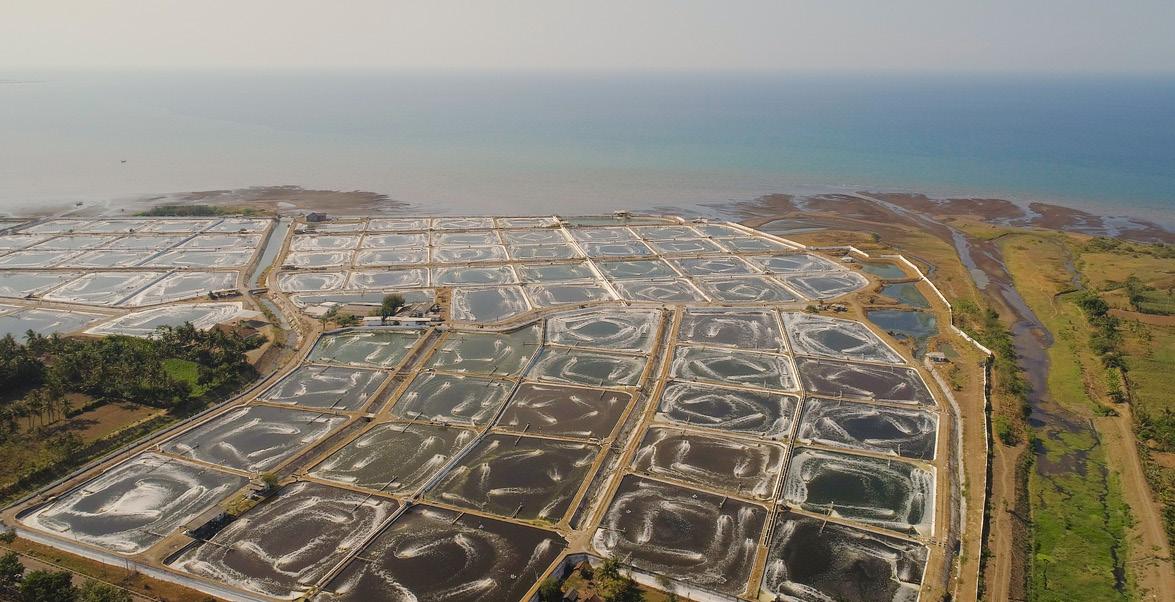
can threaten population sustainability (Baroiller et al., 2009).
8. Reduced egg viability
Elevated temperatures can negatively affect egg development, leading to lower hatching success and increased mortality rates of embryos. Thermal stress during the embryonic stage can cause deformities and reduce the overall fitness of larvae (Alderdice and Forrester et al., 1971).
9. Decreased sperm quality
Male fish exposed to higher temperatures may produce less viable sperm. Heat stress can reduce sperm motility and longevity, impairing fertilization success and affecting the reproductive output of populations (Lahnsteiner et al., 1999).
10. Behavioral changes
Temperature rise can alter reproductive behaviors such as courtship and nest building. These behavioral mod-
Effect
ifications can lead to reduced mating success and affect the reproductive efficiency of fish populations (Kamler et al., 2005).
11. Geographical shifts and migration
Warming waters can drive fish to migrate to cooler regions, which might disrupt local ecosystems and lead to mismatches between fish species and their traditional spawning habitats. This shift can cause changes in the genetic diversity and resilience of fish populations (Perry et al., 2005).
12. Increased disease susceptibility
Higher temperatures can enhance the prevalence and severity of diseases and parasites, which can affect reproductive health and success. Infected fish may have reduced reproductive capacity or transmit pathogens to offspring (Harvell et al., 2002).

13. Metabolic stress
Rising temperatures can increase metabolic rates in fish, leading to higher energy demands. This can divert energy away from reproduction towards maintenance and survival, thereby reducing reproductive investment and success (Pörtner and Farrell et al., 2008)
14. Effect on sexual determination and sex change
Temperature influences sex determination, with thermosensitive genes affecting aromatase biosynthesis, leading to an imbalance in sexual steroids and potential masculinization (Guiguen et al., 2010). Temperature can impede or induce sex change in sequentially hermaphroditic species by influencing the expression of aromatase genes (Nakamura et al., 2003).
In summary, temperature is a crucial factor in the reproduction of fish, affecting different phases of their reproductive cycle. The water temperature is the primary environmental factor that significantly affects the maturity of gonads and the process of breeding. Every aquatic organism has specific temperature and pH requirements for the development of reproductive organs, the process of releasing eggs or sperm, and overall growth. Therefore, fluctuations in water temperature might impact the development and regular behaviour of aquatic organisms.
References and sources consulted by the author on the elaboration of this article are available under previous request to our editorial staff. Bhavesh Choudhary Ph.D. Research Scholar, Department of Aquaculture, College of Fisheries, Central Agricultural University (Imphal), Lembucherra, Agartala, 799210 Tripura, India. Arup Das College of Fisheries, Central Agricultural University (Imphal), Lembucherra, Agartala, 799210 Tripura, India. Nayan Chouhan Ph.D. Research Scholar, Department of Aquatic Health & Environment, College of Fisheries, Central Agricultural University (Imphal), Lembucherra, Agartala, 799210 Tripura, India.
* By Antonio Garza de Yta, Ph.D.
Many countries are interested in developing aquaculture, with varying levels of resources and capital. Regardless of the circumstances, it is crucial to prioritize human capital development in planning and investment strategies.
The Aquaculture Europe event in Denmark, held every six years in coordination with the European Society and the World Aquaculture Society, has just concluded. It is my assessment that this is the most comprehensive aquaculture event in the global arena. At these European events, academia and industry come together, and it is evident that the trajectory of global aquaculture advancement over the coming decades can be discerned. It is clear that such an event provides a significant boost to business and opportunities for the host country. It is also a testament to the success of decision-makers who invest wisely in promoting aquaculture and expanding their industry and academic networks. It would be unwise to miss such an opportunity if it arises.
In conversation with one of the Danish engineers involved in one of the most significant recirculating aquaculture systems (RAS) projects globally, he shared insights that proved pivotal to my understanding. “We distinguish between customers who are primarily interested in producing fish and those who are primarily interested in making money.”
I believe this accurately reflects the current state of aquaculture. While many of us are focused on continuing to produce fish (for the sake of simplicity, I will refer to all aquatic organisms as fish), others have viewed the activity primarily as a source of funding, rather than as a means of achieving tangible results.
When an individual decides to engage in fish production, they are aware that the return on investment
will likely not match that of a technology or hydrocarbon company. However, they recognize that the journey, despite its challenges, offers significant fulfillment. We remain an agricultural business, requiring effort, routine, and work. Currently, numerous financiers are dedicated to aquaculture, seeking the opportunity to become millionaires overnight. I have a message for all of them: this is aquaculture, and there are no quick fixes or magic formulas. Instead, success depends on consistency, preparation, standardization, and hard work.
We are also witnessing significant advancements in artificial intelligence and automated processes. While I am a strong proponent of these developments, I believe it is essential to ensure that the industry does not become dehumanized

Many countries are interested in developing aquaculture, with varying levels of resources and capital. Regardless of the circumstances, it is crucial to prioritize human capital development in planning and investment.
Aquaculture professionals remain a crucial element in the success of the industry. The effective operation of processes and the appropriate utilisation of these tools will undoubtedly enhance efficiency, provided that we comprehend the principles of aquaculture and the interactions and consequences of these new equipment on the organisms and the quality of the water.
Denmark provides an excellent case study of how a country can develop its human capital and drive economic growth. The country’s companies are not only producing wealth in the region but also applying their technology and selling their products worldwide. Examples of these companies include those selling feed, recirculation systems, equipment for remote monitoring of water physico-
chemical factors, filtering systems, and engineering. Denmark is widely recognized as a global leader in technology and development, particularly in the aquaculture sector.
Many countries are interested in developing aquaculture, with varying levels of resources and capital. Regardless of these differences, it is crucial to prioritize human capital development as a key driver for success in this and other sectors. I have observed numerous historic opportunities being missed due to a lack of focus on professionalizing the sector and a tendency to prioritize superficial aspects over the fundamental requirements.
I believe that today we should also categorize countries, as our Danish colleague does, between those who prioritize fish production and
those who prioritize financial gain. For those who choose the former, the road is challenging, but the longterm benefits of a consolidated aquaculture industry will justify the effort. Hopefully, there will be many who are inclined to do so!
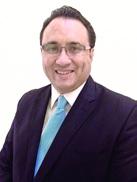
* Antonio Garza de Yta is COO of Blue Aqua International-Gulf, Vice President of the International Center for Strategic Studies in Aquaculture (CIDEEA), President of Aquaculture Without Frontiers (AwF), Past President of the World Aquaculture Society (WAS), Former Secretary of Fisheries and Aquaculture of Tamaulipas, Mexico, and Creator of the Certification for Aquaculture Professionals (CAP) Program with Auburn University.
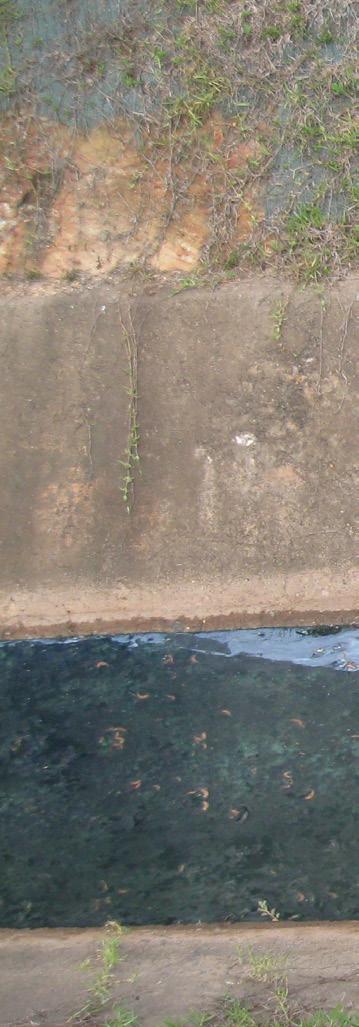
P* By Stephen Newman, Ph.D.
ost graduate school, while developing the first commercial fish vaccines, I began to learn about the then infant salmon farming industry and traveled extensively visiting operations in many countries. Flow through cage and smolt production systems were the norm and RAS was very much in its infancy. With clean water available, many problems were avoided. In hindsight some, if not most, of the current challenges appeared to occur as a result of a rapidly growing industry that put pressure on the availability of adequate clean
water resources. In the early 1990s I started focusing on shrimp farming. As with the salmon farming industry, these were early days and there were few concerns with the negative impacts of discharging wastes into the environment.
However, with more than 8 billion people on the planet today, it is apparent that we cannot continue to dump untreated or inadequately treated waste streams into the environment without seeing negative impacts. The oceans were looked upon as being impossible to damage. Now it is widely recognized this is not
reality. Note that there have always been some who saw this well before it became a problem. Yet we persist in using the worlds water resources as a waste receptacle.
Humanity must become environmental stewards if we are not to exceed the carrying capacity of the environment with all of its horrific potential consequences. The evidence suggest that we are already well along this path in some areas. Imagine an ocean without fish or vast areas on land that cannot support agriculture because of polluted ground water. This is a complex sub-
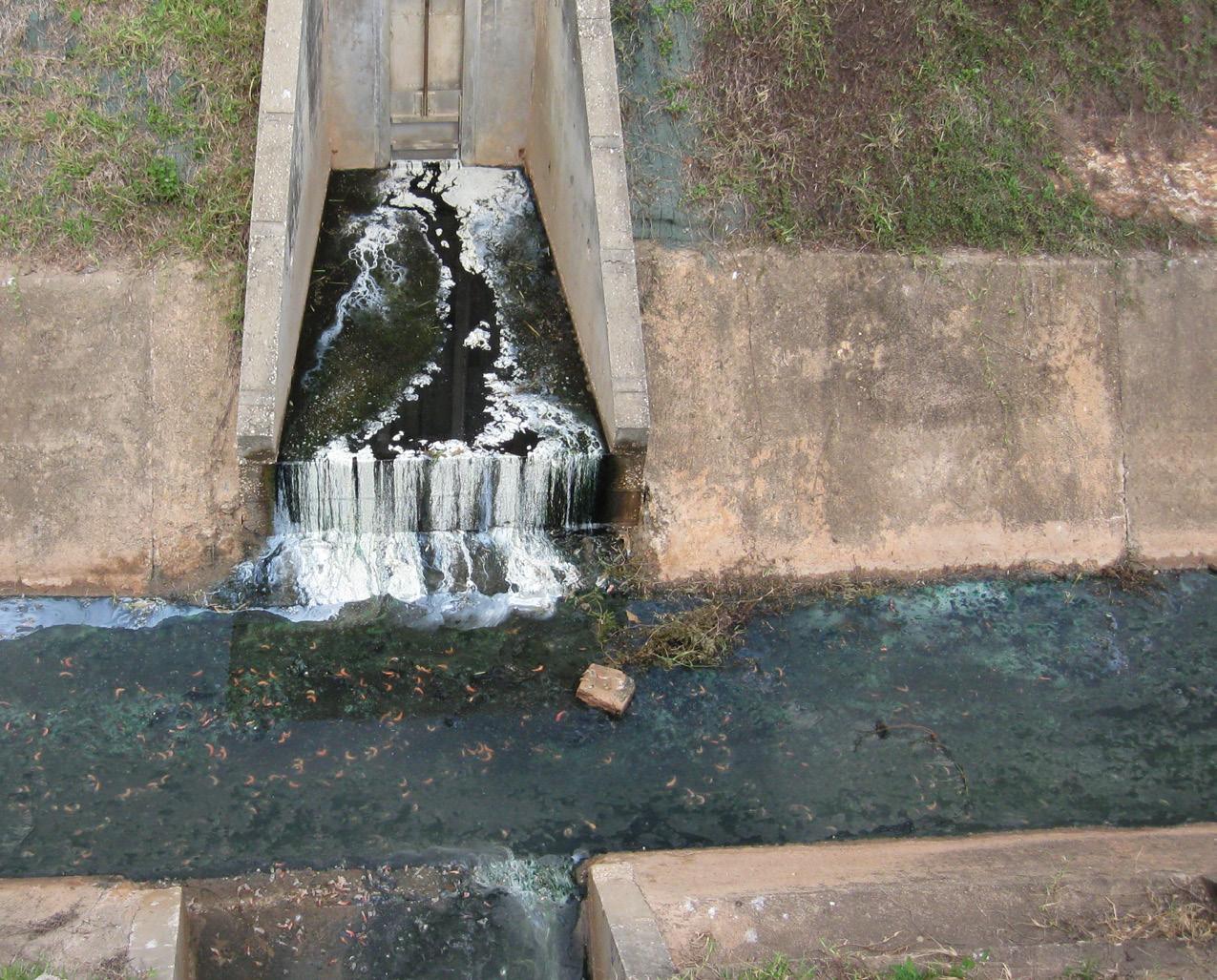
When I was in university in the late 1960’s and early 1970’s, I was a bit adrift like so many of my peers. A war was raging and many of us had no idea what we could look forward to. I chose a major that the University of Maryland only recently had developed and found myself sitting through ecology courses. Perhaps the biggest message that I took home was that ecosystems are in a delicate balance and their complexities often masked their vulnerabilities. This balance can be all to easily disrupted with significant impacts, many of which may not become apparent until after the fact.

As the human population continues to increase, this can shape environments in ways that make them less hospitable for human beings.
ject, and it is not my intention to offer anything but my perspective on what I see as a serious problem. There are many components to this including greenhouse gases which I will not be addressing specifically, nor will I be addressing the environmental costs of feed production and many other aspects of environmental impacts in aquaculture.
The most egregious offenders against the environment are municipalities that dump raw sewage or partially treated effluents into the local water ways, whether rivers, lakes or the oceans. They use these as dumping grounds while assuming that the vast amount of water is not something we can damage. The evidence is clear.
Eighty percent of the sewage that humans generate is dumped into rivers and oceans without any treatment. It is estimated that more than a billion gallons are dumped into rivers and oceans daily. Pollution is affecting the productivity of areas in close proximity to human population centers. The increase in cyanophyte blooms is a troubling indicator of nutrient overload and is increasing in frequency.
Given the diversity of the global aquacultural industry, accurate figures from aquaculture regarding the quantity of wastes being added to the environment are not available.
While there are some NGO’s that cite figures along with impacts, these are not likely accurate reflections of the big picture. Furthermore, some claim that aquaculture is the reason for destruction of local aquatic environments when, in my opinion and that of many others, the dumping of untreated and inadequately treated sewage is the primary cause of most of the problems. Human sewage is the real culprit.
Environmental stewardship must be a critical component of any farming practice and aquaculture is no exception. Yes, there are examples where localized damage to the environment occurs. One that is cited often is the siting of fish net pens in shallow waters where currents do not flush heavily diluted wastes away from the site. Possible solutions to this are to use closed systems that remove the waste streams and treat them before discharging them
or move the cages to areas that are not shallow and where currents act to flush these materials and dilute them. In-situ bioremediation can also moderate the impact. Any solution will be an added cost which consumers will have to pay. Will they pay more to know that what they are eating is produced in an environmentally friendly manner? Corporate profit margins seem to be more important than environmental stewardship. Many think that consumers will choose less costly sources of protein.
Most shrimp farming is done in ponds. There are several production paradigms with the most common being dirt ponds where wastes accumulate during the production cycle. Some flush these out via water exchange, and some treat them, at least allowing them to settle, so that the water that they discharge is largely free of particulate wastes. This does not stop chemicals, anti-
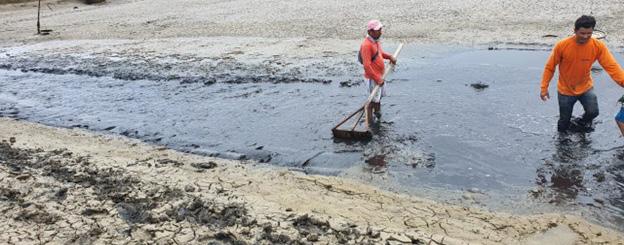
biotics and other smaller molecular weight material from being dumped. The accumulated solid wastes may be trucked off for addition to landfills or used to shore up berms in the ponds or allowed to accumulate to the point where the discharge ponds are no longer of utility.
There are several hundred thousand shrimp farmers globally with most in third world countries. The real money in shrimp farming is in the export market. China, the USA and the EU are the major importers. Most shrimp farmers are not corporations. The farms are small, and the farmers are often not financially secure. In many instances, it is subsistence farming. Although when a small farmer is successful and has right connections to market a highquality product, a fortune can be made. Typically, most farmers cannot afford or are simply unwilling to set aside a portion of their farm for ensuring that waste streams are adequately treated before discharge.
Adequate treatment is more than likely going to vary depending on what the country of productions requirements are as well as what the countries that their products end up in are. It may be that the only path requires consolidation. Shrimp (and fish) farming needs to be practiced by corporations with a diverse resource base, often vertically integrated, that can afford to ensure that the waste streams that they generate are properly managed before discharge.
There are several possible approaches. These include using high rates of water exchange to flush out these materials as they accumulate. This however reaches a point where it is simply not viable, typically because of the lack of access to clean water in the quantities needed and the costs associated with moving the water. The wastes are essentially dumped untreated into the environment which makes this an unsuitable approach towards environmental stewardship. In many areas, farms are packed so tightly that one farms influent is another’s effluent.
Biofloc is one tool that is in use. These are suspended particles of organic matter colonized by a wide range of microbes that digest this in situ. They are kept in suspension by aeration. However, the amount of aeration required in many instances to keep the particles in suspension and prevent wastes from accumulating on pond bottoms can be quite high and an undesirable stress on the animals in the ponds who must expend energy fighting currents. Some companies will keep the biofloc and reuse it while others discharge it in waste streams. Perhaps the best approach, at a cost, is to impound the waste streams and treat them to reduce the organic loads and detoxify chemicals and other compounds of concern to reduce them to “acceptable” levels.
Environmental stewardship is not that complicated. However, determining how best to do it can be and certainly appears to be divisive. Some believe that the solution lies in banning all aquaculture operations in the misguided belief that the environmental impacts are far worse than the reality. Arguing that pollution from aquaculture is horrifically damaging the environment without considering that the untreated wastes from human activity far outweigh any potential damage from aquaculture strikes me as biased and alarmist. Regardless, all agricultural and aquacultural farming practices should be practicing environmental stewardship. Where to start?
The first place I believe is to accept that it is an essential element of sustainability. If the wastes can be reconditioned in some manner that creates value, this is probably the best solution in the long term. The organic components of these wastes have nutritional value that can be recycled. One possible example would be drying the material and feeding it to insects that are the source of insect meals, a potential replacement for fish meal. There are of course economic issues that will impact this. Insect meals are not at the price point
where they are less costly than fish meal. This is likely to change as a burgeoning human population drives the demand for increases in seafood in their diets which can only be met via aquaculture.
If reuse is not economically viable, then collecting the wastes and treating them with aeration and microbial bioaugmentation to ensure that the nutritive elements that are being dumped are not damaging the receiving waters is a suitable approach. This entails reducing the amount of pond area available for production, although there is nothing that stops these waste ponds from being used for growing salt tolerant plants or some aquatic animals that are marketable. Ideally, the nature of the treatment should reduce heavy metal levels, pesticides, antibiotics and degrade the feces, molts and other components of the waste stream.
The simple fact is that humanity cannot continue to use the oceans and various other bodies of waters as dumping ground for its wastes. While aquaculture may only contribute a small amount compared to direct human waste streams, environmental stewardship demands that every effort be made to lessen any source.
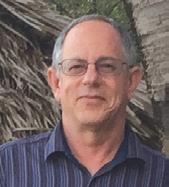
* Stephen G. Newman has a bachelor’s degree from the University of Maryland in Conservation and Resource Management (ecology) and a Ph.D. from the University of Miami, in Marine Microbiology. He has over 40 years of experience working within a range of topics and approaches on aquaculture such as water quality, animal health, biosecurity with special focus on shrimp and salmonids. He founded Aquaintech in 1996 and continues to be CEO of this company to the present day. It is heavily focused on providing consulting services around the world on microbial technologies and biosecurity issues.
sgnewm@aqua-in-tech.com www.aqua-in-tech.com
www.bioremediationaquaculture.com www.sustainablegreenaquaculture.com.
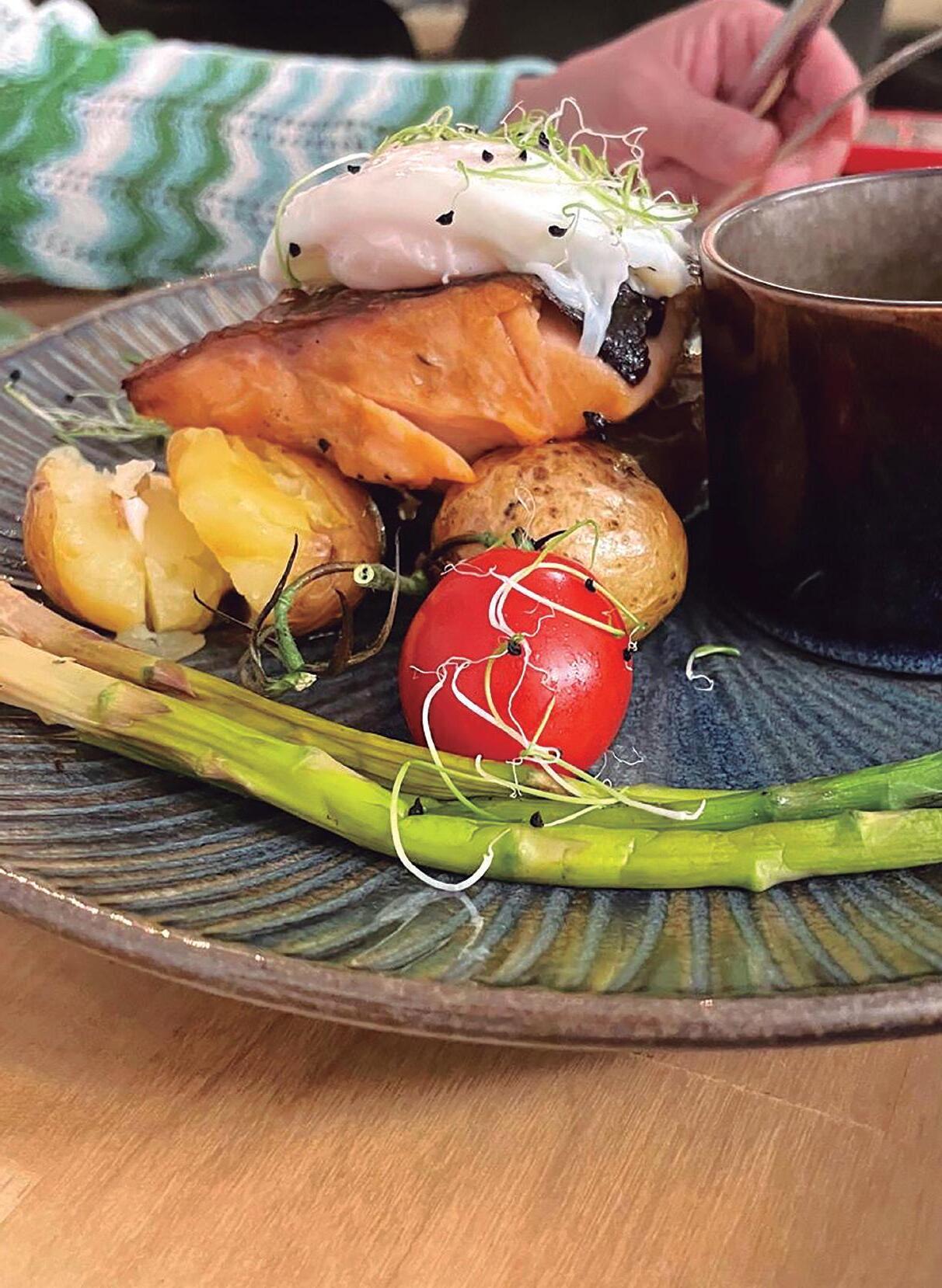
* By FishProf
The blockages of getting good medical advice about prevention are immense. Whether that be big pharma; media continuing to promote myths to fester; the anti-seafood groups or governments that do not do their homework it is frustrating working in this space. We must not give up in getting the facts on the table!
Everyone should have a good read of Dr. Rachel Gow’s book “Smart Foods for ADHD and Brain Health”. Rachel is a Nutritional Neuroscientist, Neuropsychologist and Neurodevelopmental specialist with expertise in a range of mental health conditions and associative learning and behavior differences plus a Registered Nutritionist (under the category of Science).
Dr. Gow has a personal interest which has been a driver for her efforts to get to the truth on these issues as her son, has ADHD and Dyslexia. Rachel founded Nutritious Minds Consulting and then Nutritious Minds Trust in 2019. Her studies have seen her engaged in over twenty years of research and experience in psychological research in child/adolescent and adult clinical populations and have seen involvement in programs run by medical research gurus on both sides of the Atlantic.
Professor John Stein has said of Rachel “I so admire Rachel. She has sacrificed a successful and lucrative career in real estate for the dubious delights of neuroscience research – insecure employment, ferocious competition, not to mention misogyny – in order to better understand and help ADHD. Using her formidable determination, intelligence and networking talents, she has overcome most of the obstacles thrown in her way to achieve the extraordinary understanding and practical helpfulness clinically that is shown in spades in this book.”
As an example, Dr. Gow was the Lead Associate Investigator of the Neuroimaging, Omega‐3 and Reward in Adults with ADHD (NORAA) trial at the National Institutes of Health (NIH) in Bethesda, Maryland, U.S. This study
The FishProf believes that seafood consumpti on has the answers to many of the world’s chronic diseases, longer life and good health
but, sadly,
the money is centred more on cure rather than prevention.
was the first randomized, double‐blind, placebo‐controlled, clinical trial globally to test the effects of omega‐3 fats in the brain activity of adults with ADHD using neuroimaging techniques.
With over twenty published peer reviewed book chapters and scientific papers Rachel has shown that she has extensive knowledge in neurodiverse learning and behavioral differences and the effects of dopamine enhancing brain‐selective nutrients. Add to this the ‘real life’ experiences with her son and you can see that you are dealing with someone who has all the skills, expertise and knowledge.
As Rachel highlights “The world is already full of dietary plans and often dietary advice is out of date and arguably misleading”.
Omega-3 guru Professor Michael Crawford, PhD, FRSB, FRC Path highlights that “With mental ill-health on the rise, there is every good reason to read Rachel’s book. Changing one’s diet isn’t easy, and Rachel (in Chapter 10) provides tools for making those changes, including a chart for meal planning.”
Sometimes The FishProf believes we need the world to stop and take stock and assess what is right and wrong. Flush the arteries of global information with a truth serum based on peer reviewed medical science and reset. Get the specialists like Rachel in the process and start with how we can all eat healthy and avoid many of the chronic diseases that are impacting every corner of the world.
The FishProf noted that recently Robert F. Kennedy Jr. being quoted as follows “Today, two-thirds of Ameri-
can adults and half of children suffer chronic health issues. Fifty years ago, the number for children was less than one per cent.”
“In America, 74 per cent of adults are now overweight or obese, and close to 50 per cent of children. In Japan, the childhood obesity rate is three per cent. Half of Americans now have prediabetes or type 2 diabetes.”
“There’s been an explosion of neurological diseases that I never saw as a child. ADD, ADHD, speech delay, language delay, Tourette’s, narcolepsy, ASD, and Asperger’s.”
“In the year 2000, the autism rate was one in 1,500. Now, autism rates in kids are one in 36 nationally, and 1 in 22 in California. The screening has not changed. Nor has the definition. The incidence has changed.”
“About 18 per cent of teens have fatty liver disease, a disease that primarily used to be found only in latestage alcoholics. Cancer rates are skyrocketing in the young and the old. Young adult cancers are up 79 per cent.”
“One in four American women is on an antidepressant medication: 40 per cent of teens have a mental health diagnosis. Today, 15 per cent of high schoolers are on Adderall and half a million children are on SSRIs.”
“So, what’s causing all this suffering? I’ll name two culprits. First are ultra-processed foods. About 70 per cent of American children’s diet is ultra-processed – industrially manufactured in a factory. These foods consist primarily of processed sugar, ultra-processed grains, and seed oils.”
“Lab scientists concoct thousands of other ingredients to make these foods more palatable, more addictive. These ingredients didn’t exist 100 years ago, and humans aren’t biologically adapted to eat them. Hundreds of these chemicals are banned in Europe, but ubiquitous in America’s processed foods.”
“The second culprit is toxic chemicals in our food, medicine, and environment. Pesticides, food additives, pharmaceutical drugs, and toxic waste permeate every cell of our bodies. The assault on a child’s cells and hormones is unrelenting.”
“It is crippling our nation’s finances. When my uncle was president, our country spent zero dollars on chronic disease. Today, government healthcare spending is mostly for chronic disease, and it is double the military budget. And it is the fastestgrowing cost.
“The good news is that we can change all of this and change it quickly. America can get healthy again. To do that we need to do three things. First, root out the corruption in our health agencies, all of them are controlled by huge for-profit corporations. Second, change the incentives of the healthcare system. And third, inspire Americans to get healthy again.”
This might sound like a political broadcast but everyone in the seafood industry should take note and start promoting these facts/figures and fire up against the next wave of lab foods which are trying to swindle consumers in thinking that they are eating seafood but in fact they are eating questionable manufactured products.
In Europe there are increasing attempts by meat industry lobby groups to hinder the further growth

Dr. Rachel Gow has a personal interest which has been a driver for her efforts to get to the truth on these issues as her son, has ADHD and Dyslexia. Rachel founded Nutritious Minds Consulting and then Nutritious Minds Trust in 2019.
of more sustainable alternatives under the pretext of consumer protection. Product labelling standards need more vigor. Many start-ups and established companies are therefore calling for the EU-wide regulations to be adapted, so that they not only serve the interests of industrial animal farming and aquaculture, but also allow sustainable, plant-based products to compete in a fair market.
The people of Springfield, Ohio were recently dragged into a silly non-factual media issue which had many consequences, yet we talk openly about eating “hot dogs” which clearly do not contain dog meat, and “hamburgers” which do not contain ham. We know that those items are names that have been adopted for a long time but maybe they need to be reviewed to ensure we end up with a better system and no consumer deception.
The FishProf will next be reporting from Portugal and Spain so will be on the lookout for such products and will be discussing the issue. CONXEMAR in Vigo is main part of the trip and connecting with as many people as possible. Meetings are planned with governments and industry, and I hope to have some stories to pass on.
In Lisbon there is the opportunity of catching up with people and planning for the Aqua Horizons Conference 28-30 April 2025 (https://www. europeaquacultureconference.com/ about)
One of special sessions will be on ‘Crustacean and Shellfish Research Underpinning Aquaculture and Fisheries Enhancement’ led by Professor Gregory Smith, Director of ARC Research Hub for Sustainable Onshore Lobster Aquaculture from Institute for Marine and Antarctic Studies (IMAS) University of Tasmania (https://onshorelobsteraquaculture.com.au/).
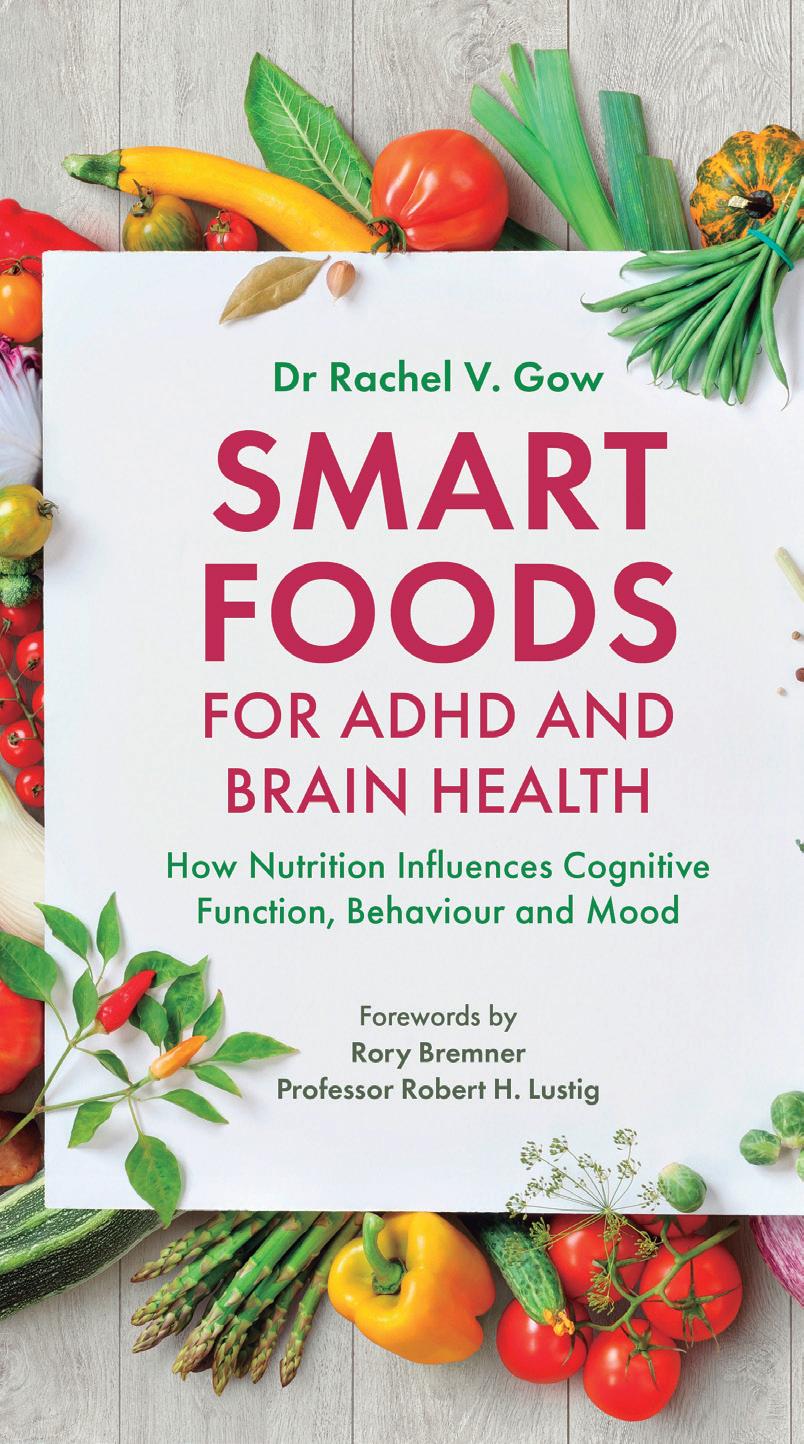

Sometimes The FishProf believes we need the world to stop and take stock and assess what is right and wrong. Flush the arteries of global information with a truth serum based on peer reviewed medical science and reset.
Greg was recently in the UK & EU and believes the timing is right to bring all interested groups (researchers, farmers, fishermen, govts, industry, NFP’s in the Spiny and European Lobster fields as well as those in Shellfish reef restoration) together to enhance prospects through exchanging ideas, building new partnerships and finding better ways to commercialize research into real world outcomes.
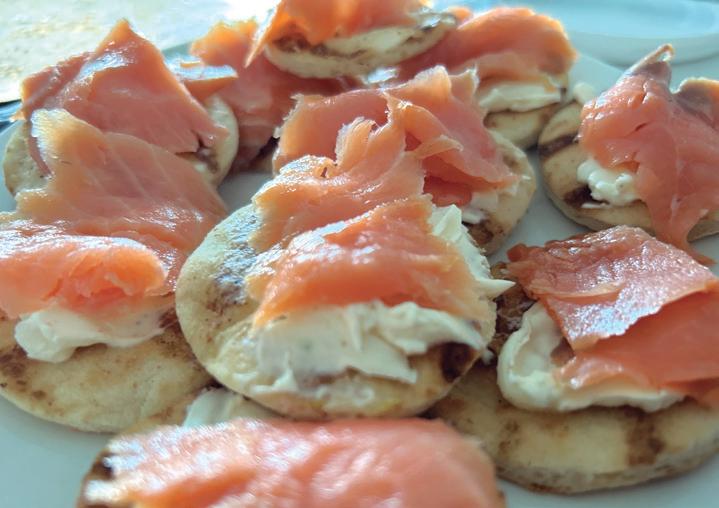

Your opportunity is to jump on the website, register, put in an interesting abstract and make plans for an interactive event and let us create some relevant outcomes.
NOTE: Dr Rachel Gow’s published book, “Smart Foods for ADHD and Brain Health”, is available to order on Amazon (Jessica Kingsley Publishers part of the Hachette UK Group).
Many start-ups and established companies are therefore calling for the EU-wide regulations to be adapted, so that they not only serve the interests of industrial animal farming and aquaculture, but also allow sustainable, plant-based products to compete in a fair market.
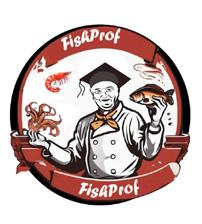
References and sources consulted by the author on the elaboration of this article are available under previous request to our editorial staff.
Regular contributor The Fishmonger has now morphed into FishProf and will continue contributing to AQUACULTURE MAGAZINE but also welcomes all the readers to connect through www.fishprof.com and join in our promotions to increase seafood consumption globally.

OCTOBER 2024
AGRAME
Oct. 07-08, 2024
Dubai World Trade Centre
Dubai, UAE
T: +44 (0) 7305288348
E: brent.crosbie@informa.com
W: https://informaconnect.com/agra-middleeast/
FUTURE FISH EURASIA
Oct. 10-12, 2024
Izmir, Turkey
T: +90 212 347 10 54 (pbx)
E: info@eurasiafairs.com
W: eurasiafairs.com/eng/index.html
AQUAEXPO GUAYAQUIL 2024
Oct. 21-24, 2024
Guayaquil, Ecuador
T: (+593) 4 268 3017 ext. 124
E: cmosquera@cna-ecuador.com
W: www.aquaexpo.com.ec/
SEAFOOD SHOW LATINAMERICA
Oct. 22-24, 2024
Anhembi Distrit, Sao Paulo, Brazil
T: (11) 2226-3100
E: cs@francal.com.br
W: https://seafoodshow.com.br/
CHINA FISHERIES & SEAFOOD EXPO
Oct. 30-Nov. 1, 2024
Beijing 100022 P.R. China
T: +86 10 58672620
E: info@seafarechina.com
W: https://chinaseafoodexpo.com/
NOVEMBER 2024
AQUACULTURE SPECIALIZATION DIPLOMA (Universidad Politécnica de Valencia)
From Nov. 4, 2024 to June 30, 2024*
On line
T: +34 963877434
E: igjaugar@doctor.upv.es
W: cfp.upv.es/formacion-permanente/curso/ diploma-especializacion-acuicultura_98499. html www.cursodeacuicultura.upv.es
BUSAN INTERNATIONAL SEAFOOD & FISCHERIES EXPO 2024 (BISFE 2024)
Nov. 6-8, 2024
Busan Metropolitan City, Korea
T: +82-51-740-7518, 7519
E: bisfe@bexco.co.kr
W: https://bisfe.com/eng/sub04/sub02.php
FIRST CONGRESS ON ANTIBIOTICS IN AQUACULTURE: A MULTIDISCIPLINARY APPROACH TO SUSTAINABILITY
Nov. 20-22, 2024
Puerto Varas, Chile
E: antibioticcongress2024@intesal.cl W: https://www.antibioticcongress.com/
AQUACULTURE AFRICA 2024
Nov. 20-23, 2024
Hammamet, Tunisia
T: (+1) 760 751 5005
Fax: (+1) 760 751 5003
E: worldaqua@was.org W: www.was.org
ANTIBIOTICS, PROBIOTICS AND FEED ADDITIVES
CARGILL (EMPYREAL)......................................5 www.empyreal75.com
CARGILL (MOTIV).........................INSIDE COVER www.motivshrimp.com
AERATION EQUIPMENT, PUMPS, FILTERS AND MEASURING INSTRUMENTS, ETC
DELTA HYDRONICS LLC....................................9
T: 727 861 2421
www.deltahydro.com
TANKS AND NETWORKING FOR AQUACULTURE
REEF INDUSTRIES..........................BACK COVER 9209 Almeda Genoa Road Z.C. 7075, Houston, Texas, USA.
Contact: Gina Quevedo/Mark Young/ Jeff Garza. T: Toll Free 1 (800) 231-6074 T: Local (713) 507-4250
E-mail: gquevedo@reefindustries.com / jgarza@reefindustries.com / myoung@reefindustries.com www.reefindustries.com
AQUACULTURE MAGAZINE.....1, INSIDE BACK COVER
Design Publications International Inc. 401 E Sonterra Blvd. Sté. 375 San Antonio, TX. 78258, USA Office: +210 504 3642 Office in Mexico: +52(33) 8000 0578 - Ext: 8578
Subscriptions: iwantasubscription@dpinternationalinc.com
Sales & Marketing Coordinator crm@dpinternationalinc.com | Cell: +521 33 1466 0392 Sales Support Expert sse@dpinternationalinc.com | Cell:+521 333 968 8515 www.aquaculturemag.com
CONACUA
Nov. 29-30, 2024
Los Monchis, Mexico
T: 668 103 0484/668 815 6227/555 563 4600 W: conacua.com
FEBRUARY 2025
SIMEC AQUAFISH
Feb. 3-5, 2025
Riyad, Saudi Arabia
T: +966 506467847
E: exhibition@cityevents.com.sa
W: https://en.simec-expo.com
MARCH 2025
AQUACULTURE 2025
March 6-10, 2025
New Orleans, USA
T: (+1) 760 751 5005
Fax: (+1) 760 751 5003
E: worldaqua@was.org W: www.was.org
APRIL 2025
WORLD AQUACULTURE 2025
April 24-27, 2025
Qingdao, China
T: (+1) 760 751 5005
Fax: (+1) 760 751 5003
E: worldaqua@was.org W: www.was.org
3rd. INTERNATIONAL CONFERENCE AND EXHIBITION ON AQUACULTURE & FISHERIES (AQUACULTURE HORIZONS 2025)
April 28-30, 2025
Lisbon, Portugal W: https://www.europeaquacultureconference.com/
Panorama Acuícola Magazine
Empresarios No. #135 Int. Piso 7 Oficina 723 Col. Puerta de Hierro, C.P.45116 Zapopan, Jal.México Office: +52 (33) 8000 0578
Contact 1: Subscriptions
E-mail: suscripciones@panoramaacuicola.com Office: +52 (33) 8000 0629 y (33) 8000 0653
Contact 2: Sales & Marketing Coordinator. crm@dpinternationalinc.com | Cell: +521 33 1466 0392
Contact 3: Sales Support Expert
E-mail: sse@dpinternationalinc.com www.panoramaacuicola.com
